자습서: 백 엔드 서비스를 통해 Azure Notification Hubs를 사용하여 Flutter 앱에 푸시 알림 보내기
이 자습서에서는 Azure Notification Hubs를 사용하여 Android 및 iOS를 대상으로 하는 Flutter 애플리케이션에 알림을 푸시합니다.
ASP.NET Core Web API 백 엔드는 최신의 최상의 설치 방법을 사용하여 클라이언트에 대한 디바이스 등록을 처리하는 데 사용됩니다. 또한 서비스는 플랫폼 간 방식으로 푸시 알림을 보냅니다.
이러한 작업은 백 엔드 작업에 Notification Hubs SDK를 사용하여 처리됩니다. 전체 접근 방식에 대한 자세한 내용은 앱 백 엔드에서 등록 설명서에 나와 있습니다.
이 자습서에서는 다음 단계를 안내합니다.
사전 요구 사항
따라가려면 다음이 필요합니다.
- 리소스를 만들고 관리할 수 있는 Azure 구독 입니다.
- Flutter 도구 키트(필수 구성 요소와 함께).
- Flutter 및 Dart 플러그 인이 설치된 Visual Studio Code.
- 라이브러리 종속성을 관리하기 위해 설치된 CocoaPods입니다.
- Android(물리적 또는 에뮬레이터 디바이스) 또는 iOS(물리적 디바이스에만 해당)에서 앱을 실행하는 기능입니다.
Android의 경우 다음이 있어야 합니다.
- 개발자가 물리적 디바이스 또는 에뮬레이터 (Google Play 서비스가 설치된 API 26 이상을 실행)의 잠금을 해제했습니다.
iOS의 경우 다음이 있어야 합니다.
- 활성 Apple 개발자 계정.
- 개발자 계정에 등록된 물리적 iOS 디바이스(iOS 13.0 이상 실행).
- 물리적 디바이스에서 앱을 실행할 수 있도록 키체인 설치된 .p12개발 인증서입니다.
참고
iOS 시뮬레이터는 원격 알림을 지원하지 않으므로 iOS에서 이 샘플을 탐색할 때 물리적 디바이스가 필요합니다. 그러나 이 자습서를 완료하기 위해 Android 와 iOS 모두에서 앱을 실행할 필요는 없습니다.
이전 경험 없이 이 첫 번째 원칙 예제의 단계를 따를 수 있습니다. 그러나 다음과 같은 측면을 잘 알고 있으면 도움이 됩니다.
- Apple 개발자 포털.
- ASP.NET Core.
- Google Firebase 콘솔.
- Microsoft Azure 및 Azure Notification Hubs를 사용하여 iOS 앱에 푸시 알림 보내기
- 플랫폼 간 개발을 위한 Flutter 및 Dart.
- Android 및 iOS 네이티브 개발을 위한 Kotlin 및 Swift.
제공된 단계는 macOS와 관련이 있습니다. iOS 측면을 건너뛰어 Windows에서 따라갈 수 있습니다.
푸시 알림 서비스 및 Azure Notification Hub 설정
이 섹션에서는 FCM(Firebase Cloud Messaging) 및 APNS(Apple Push Notification Services)를 설정합니다. 그런 다음, 해당 서비스와 작동하도록 알림 허브를 만들고 구성합니다.
Firebase 프로젝트 만들기 및 Android용 Firebase Cloud Messaging 사용
Firebase 콘솔에 로그인합니다. 프로젝트 이름으로 PushDemo를 입력하는 새 Firebase 프로젝트를 만듭니다.
참고
고유한 이름이 생성됩니다. 기본적으로 제공한 이름의 소문자 변형과 대시로 구분된 생성된 숫자로 구성됩니다. 여전히 전역적으로 고유하다는 것을 제공하려는 경우 이를 변경할 수 있습니다.
프로젝트를 만든 후 Android 앱에 Firebase 추가를 선택합니다.

Android 앱에 Firebase 추가 페이지에서 다음 단계를 수행합니다.
Android 패키지 이름에 패키지 이름을 입력합니다. 예:
com.<organization_identifier>.<package_name>.
앱 등록을 선택합니다.
다운로드 google-services.json 선택합니다. 그런 다음 나중에 사용할 수 있는 로컬 폴더에 파일을 저장하고 다음을 선택합니다.
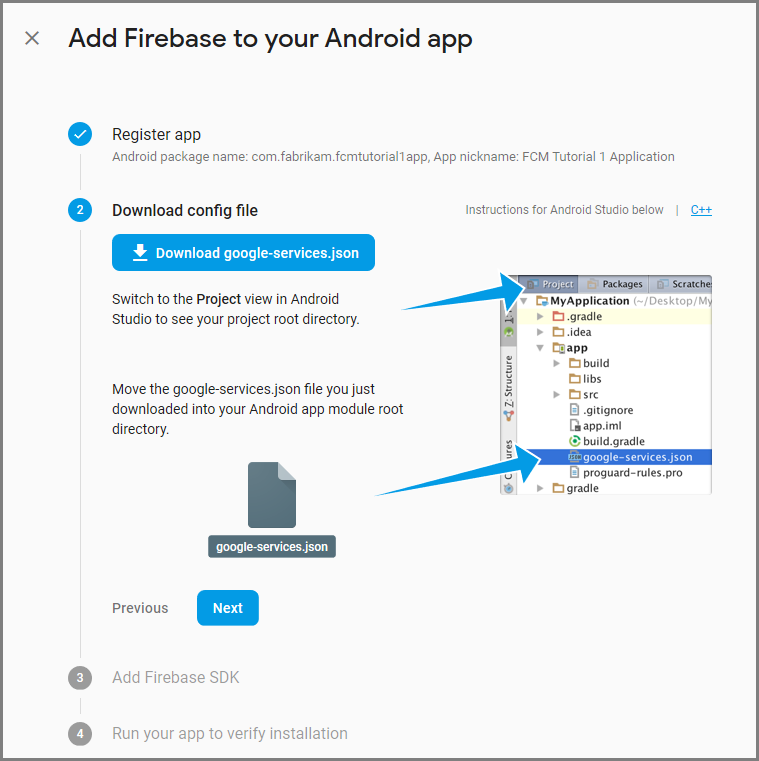
다음을 선택합니다.
콘솔로 계속을 선택합니다.
참고
설치 확인 검사 인해 콘솔로 계속 단추를 사용할 수 없는 경우 이 단계 건너뛰기를 선택합니다.
Firebase 콘솔에서 프로젝트의 톱을 선택합니다. 그런 다음 프로젝트 설정을 선택합니다.

참고
google-services.json 파일을 다운로드하지 않은 경우 이 페이지에서 다운로드할 수 있습니다.
위쪽의 클라우드 메시징 탭으로 전환합니다. 나중에 사용할 수 있는 서버 키를 복사하고 저장합니다. 이 값을 사용하여 알림 허브를 구성합니다.

푸시 알림에 대한 iOS 앱 등록
iOS 앱에 푸시 알림을 보내려면 Apple에 애플리케이션을 등록하고 푸시 알림에 등록합니다.
앱을 아직 등록하지 않은 경우 Apple 개발자 센터에서 iOS 프로비저닝 포털 로 이동합니다. Apple ID를 사용하여 포털에 로그인하고 인증서, 식별자 & 프로필로 이동한 다음 식별자를 선택합니다. 새 앱을 등록하려면 클릭합니다 + .

새 식별자 등록 화면에서 앱 ID 라디오 단추를 선택합니다. 그런 다음 , 계속을 선택합니다.

새 앱에 대해 다음 세 가지 값을 업데이트한 다음 계속을 선택합니다.
설명: 앱의 설명이 포함된 이름을 입력합니다.
번들 ID: com.organization_identifier<> 양식의 번들 ID를 입력합니다.<>앱배포 가이드에 설명된 대로 product_name. 다음 스크린샷에서는 값이
mobcatorganization 식별자로 사용되고 PushDemo 값이 제품 이름으로 사용됩니다.
푸시 알림: 기능 섹션에서 푸시 알림 옵션을 확인 합니다 .
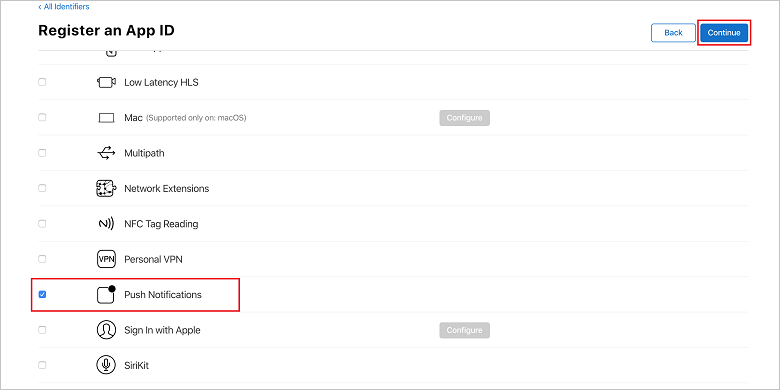
이 작업은 앱 ID를 생성하고 정보를 확인하는 요청을 생성합니다. 계속을 선택한 다음 등록을 선택하여 새 앱 ID를 확인합니다.
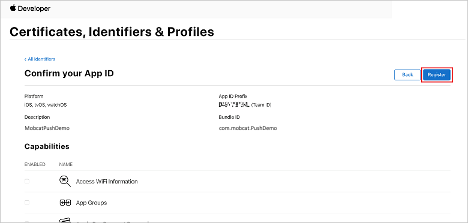
등록을 선택하면 인증서, 식별자 & 프로필 페이지에 새 앱 ID가 줄 항목으로 표시됩니다.
인증서, 식별자 & 프로필 페이지의 식별자 아래에서 만든 앱 ID 줄 항목을 찾습니다. 그런 다음 해당 행을 선택하여 앱 ID 구성 편집 화면을 표시합니다.
Notification Hubs에 대한 인증서 만들기
알림 허브가 APNS(Apple Push Notification Services) 와 작동할 수 있도록 하려면 인증서가 필요하며 다음 두 가지 방법 중 하나로 제공할 수 있습니다.
토큰 기반 인증에 사용할 수 있는 p8 인증서 만들기 (최신 및 권장 방법)
최신 접근 방식에는 APNS에 대한 토큰 기반(HTTP/2) 인증에 설명된 대로 다양한 이점이 있습니다. 더 적은 단계가 필요하지만 특정 시나리오에도 필수입니다. 그러나 이 자습서의 목적에 따라 둘 다 작동하므로 두 방법 모두에 대한 단계가 제공되었습니다.
옵션 1: Notification Hub에 직접 업로드할 수 있는 p12 푸시 인증서 만들기
Mac에서 키 집합 액세스 도구를 실행합니다. 유틸리티 폴더 또는 실행 패드의 기타 폴더에서 열 수 있습니다.
키 집합 액세스를 선택하고 인증서 도우미를 확장한 다음 인증 기관에서 인증서 요청을 선택합니다.
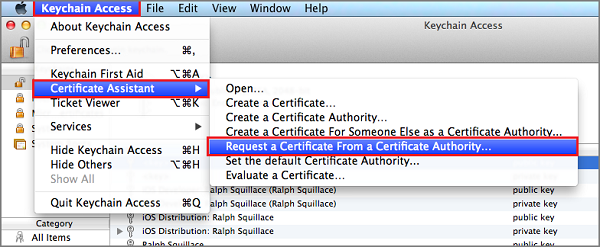
참고
기본적으로 키 집합 액세스는 목록의 첫 번째 항목을 선택합니다. 인증서 범주에 있고 Apple Worldwide 개발자 관계 인증 기관이 목록의 첫 번째 항목이 아닌 경우 문제가 될 수 있습니다. CSR(인증서 서명 요청)을 생성하기 전에 키가 아닌 항목이 있거나 Apple Worldwide 개발자 관계 인증 기관 키가 선택되어 있는지 확인합니다.
사용자 Email 주소를 선택하고, 일반 이름 값을 입력하고, 디스크에 저장됨을 지정한 다음, 계속을 선택합니다. CA Email 주소는 필요하지 않으므로 비워 둡니다.
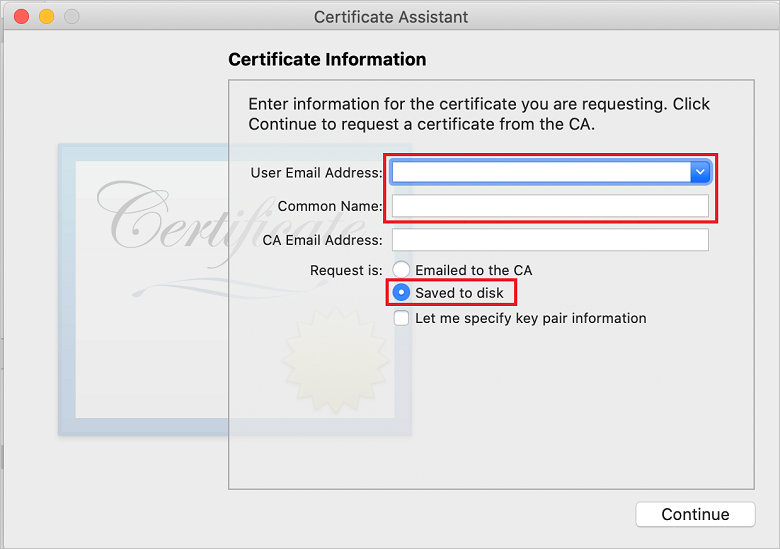
다른 이름으로 저장에 CSR(인증서 서명 요청) 파일의 이름을 입력하고 위치에서 위치를 선택한 다음 저장을 선택합니다.

이 작업은 선택한 위치에 CSR 파일을 저장합니다. 기본 위치는 Desktop입니다. 파일에 대해 선택한 위치를 기억합니다.
iOS 프로비저닝 포털의 인증서, 식별자 & 프로필 페이지로 돌아가서 선택한 푸시 알림 옵션까지 아래로 스크롤한 다음 구성을 선택하여 인증서를 만듭니다.
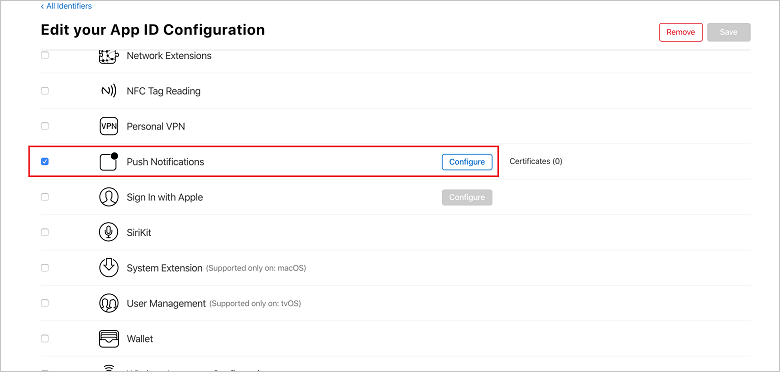
Apple 푸시 알림 서비스 TLS/SSL 인증서 창이 나타납니다. 개발 TLS/SSL 인증서 섹션에서 인증서 만들기 단추를 선택합니다.
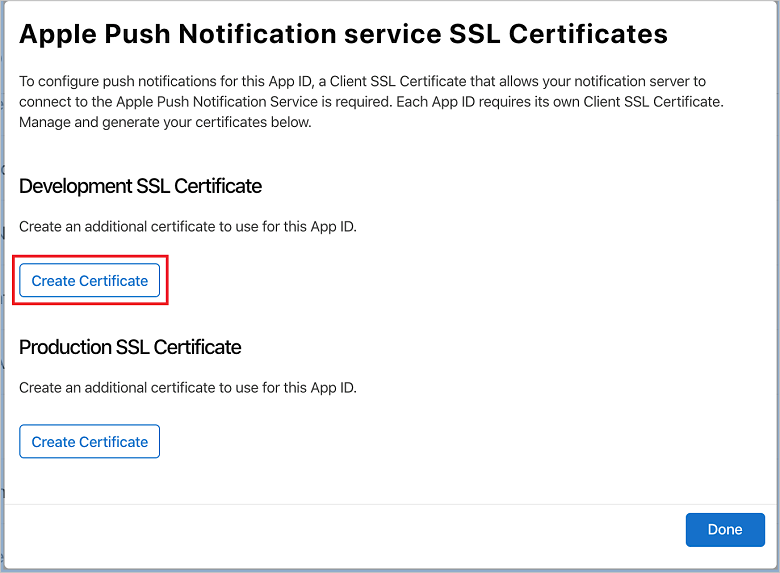
새 인증서 만들기 화면이 표시됩니다.
참고
이 자습서에서는 개발 인증서를 사용합니다. 프로덕션 인증서를 등록할 때도 동일한 프로세스가 사용됩니다. 알림을 보낼 때 동일한 인증서 유형을 사용해야 합니다.
파일 선택을 선택하고CSR 파일을 저장한 위치로 이동한 다음 인증서 이름을 두 번 클릭하여 로드합니다. 그런 다음 , 계속을 선택합니다.
포털에서 인증서를 만든 후 다운로드 단추를 선택합니다. 인증서를 저장하고 인증서가 저장된 위치를 기억합니다.

인증서가 다운로드되어 다운로드 폴더의 컴퓨터에 저장 됩니다 .

참고
기본적으로 다운로드한 개발 인증서의 이름은 aps_development.cer.
다운로드한 푸시 인증서 aps_development.cer 두 번 클릭합니다. 이 작업은 다음 이미지와 같이 키 집합에 새 인증서를 설치합니다.

참고
인증서의 이름은 다를 수 있지만 이름은 Apple Development iOS Push Services 접두사로 지정되고 적절한 번들 식별자가 연결됩니다.
키 집합 액세스에서 제어 + 인증서 범주에서 만든 새 푸시 인증서를클릭합니다. 내보내기를 선택하고, 파일 이름을 지정하고, p12 형식을 선택한 다음, 저장을 선택합니다.
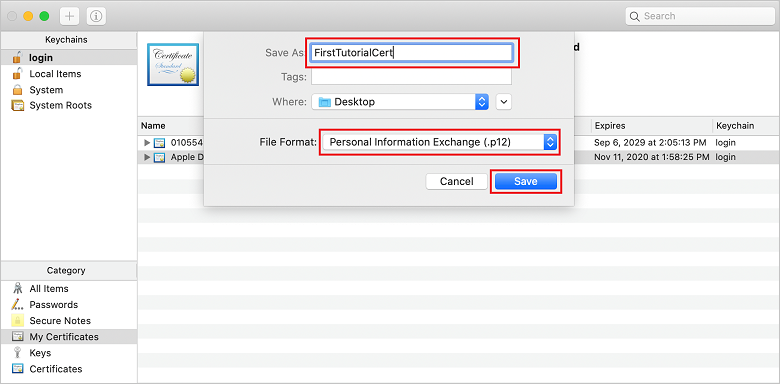
암호로 인증서를 보호하도록 선택할 수 있지만 암호는 선택 사항입니다. 암호 만들기를 무시하려면 확인을 클릭합니다. 내보낸 p12 인증서의 파일 이름과 위치를 기록해 둡다. APN으로 인증을 사용하도록 설정하는 데 사용됩니다.
참고
p12 파일 이름과 위치는 이 자습서의 그림과 다를 수 있습니다.
옵션 2: 토큰 기반 인증에 사용할 수 있는 p8 인증서 만들기
다음 세부 정보를 기록해 둡다.
- 앱 ID 접두사 (팀 ID)
- 번들 ID
인증서, 식별자 & 프로필로 돌아가서 키를 클릭합니다.
참고
APNS용으로 구성된 키가 이미 있는 경우 다운로드한 p8 인증서를 만든 직후 다시 사용할 수 있습니다. 그렇다면 3 ~ 5단계를 무시할 수 있습니다.
단추 + (또는 키 만들기 단추)를 클릭하여 새 키를 만듭니다.
적절한 키 이름 값을 입력한 다음 APNS(Apple Push Notifications Service) 옵션을 검사 다음 계속을 클릭한 다음, 다음 화면에서 등록을 클릭합니다.
다운로드를 클릭한 다음 p8 파일(AuthKey_ 접두사)을 보안 로컬 디렉터리로 이동한 다음 완료를 클릭합니다.
참고
p8 파일을 안전한 장소에 보관하고 백업을 저장해야 합니다. 키를 다운로드한 후에는 서버 복사본이 제거되므로 다시 다운로드할 수 없습니다.
키에서 만든 키(또는 대신 사용하도록 선택한 경우 기존 키)를 클릭합니다.
키 ID 값을 기록해 둡니다.
p8 인증서를 원하는 적절한 애플리케이션(예: Visual Studio Code)에서 엽니다. 키 값( -----BEGIN PRIVATE KEY----- 및 -----END PRIVATE KEY-----)을 기록해 둡니다.
-----BEGIN 프라이빗 키-----
<key_value>
----- 프라이빗 키 보내기-----참고
나중에 Notification Hub를 구성하는 데 사용할 토큰 값입니다.
이 단계가 끝나면 나중에 APNS 정보를 사용하여 알림 허브 구성에서 사용할 수 있는 다음 정보가 있어야 합니다.
- 팀 ID (1단계 참조)
- 번들 ID (1단계 참조)
- 키 ID (7단계 참조)
- 토큰 값 (8단계에서 얻은 p8 키 값)
앱에 대한 프로비저닝 프로필 만들기
iOS 프로비저닝 포털로 돌아가서 인증서, 식별자 & 프로필을 선택하고, 왼쪽 메뉴에서 프로필을 선택한 다음, 를 선택하여 + 새 프로필을 만듭니다. 새 프로비저닝 프로필 등록 화면이 나타납니다.
개발에서 프로비저닝 프로필 유형으로 iOS 앱 개발을 선택한 다음, 계속을 선택합니다.
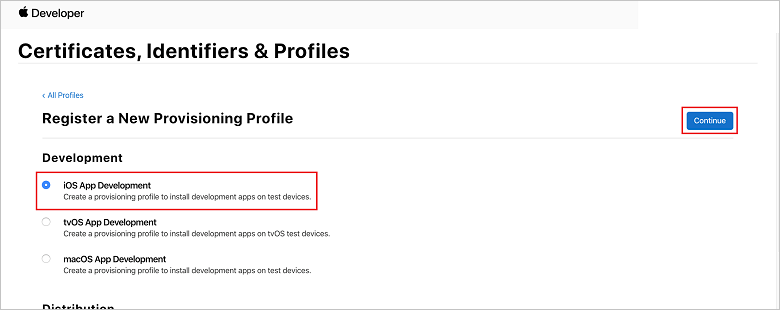
다음으로 앱 ID 드롭다운 목록에서 만든 앱 ID 를 선택하고 계속을 선택합니다.
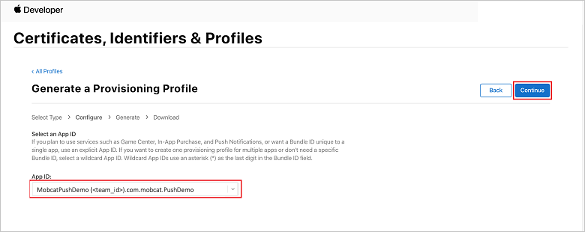
인증서 선택 창에서 코드 서명에 사용하는 개발 인증서를 선택하고 계속을 선택합니다.
참고
이 인증서는 이전 단계에서 만든 푸시 인증서가 아닙니다. 개발 인증서입니다. 없는 경우 이 자습서의 필수 구성 요소 이므로 만들어야 합니다. 개발자 인증서는 Apple 개발자 포털, Xcode 또는 Visual Studio에서 만들 수 있습니다.
인증서, 식별자 & 프로필 페이지로 돌아가서 왼쪽 메뉴에서 프로필을 선택한 다음 를 선택하여 + 새 프로필을 만듭니다. 새 프로비저닝 프로필 등록 화면이 나타납니다.
인증서 선택 창에서 만든 개발 인증서를 선택합니다. 그런 다음 , 계속을 선택합니다.
다음으로 테스트에 사용할 디바이스를 선택하고 계속을 선택합니다.
마지막으로 프로 비저닝 프로필 이름에서 프로필 이름을 선택하고 생성을 선택합니다.

새 프로비전 프로필이 만들어지면 다운로드를 선택합니다. 저장된 위치를 기억합니다.
프로비전 프로필의 위치를 찾은 다음 두 번 클릭하여 개발 컴퓨터에 설치합니다.
알림 허브 만들기
이 섹션에서는 알림 허브를 만들고 APNS를 사용하여 인증을 구성합니다. p12 푸시 인증서 또는 토큰 기반 인증을 사용할 수 있습니다. 이미 만든 알림 허브를 사용하려는 경우 5단계로 건너뛸 수 있습니다.
Azure에 로그인합니다.
리소스 만들기를 클릭한 다음 알림 허브를 검색하여 선택한 다음 만들기를 클릭합니다.
다음 필드를 업데이트한 다음 만들기를 클릭합니다.
기본 세부 정보
구독: 드롭다운 목록에서 대상 구독 선택
리소스 그룹: 새 리소스 그룹을 만들거나 기존 리소스 그룹을 선택합니다.네임스페이스 세부 정보
알림 허브 네임스페이스:Notification Hub 네임스페이스의 전역적으로 고유한 이름을 입력합니다.
참고
이 필드에 대해 새로 만들기 옵션이 선택되어 있는지 확인합니다.
알림 허브 세부 정보
알림 허브:알림 허브의 이름을 입력합니다.
위치: 드롭다운 목록에서 적합한 위치 선택
가격 책정 계층: 기본 무료 옵션 유지참고
무료 계층의 최대 허브 수에 도달하지 않는 한.
알림 허브가 프로비전되면 해당 리소스로 이동합니다.
새 알림 허브로 이동합니다.
목록에서 액세스 정책을 선택합니다( 관리 아래).
해당 연결 문자열 값과 함께 정책 이름 값을 기록해 둡다.
APNS 정보를 사용하여 알림 허브 구성
Notification Services에서 Apple을 선택한 다음 이전에 Notification Hubs용 인증서 만들기 섹션에서 선택한 접근 방식에 따라 적절한 단계를 수행합니다.
참고
스토어에서 앱을 구매한 사용자에게 푸시 알림을 보내려는 경우에만 애플리케이션 모드용 프로덕션을 사용합니다.
옵션 1: .p12 푸시 인증서 사용
인증서를 선택합니다.
파일 아이콘을 선택합니다.
이전에 내보낸 .p12 파일을 선택한 다음 열기를 선택합니다.
필요한 경우 올바른 암호를 지정합니다.
샌드박스 모드를 선택합니다.
저장을 선택합니다.
옵션 2: 토큰 기반 인증 사용
토큰을 선택합니다.
이전에 획득한 다음 값을 입력합니다.
- 키 ID
- 번들 ID
- 팀 ID
- 토큰
샌드박스를 선택합니다.
저장을 선택합니다.
FCM 정보를 사용하여 알림 허브 구성
- 왼쪽 메뉴의 설정 섹션에서 Google(GCM/FCM)을 선택합니다.
- Google Firebase 콘솔에서 적어 두는 서버 키를 입력합니다.
- 도구 모음에서 저장 을 선택합니다.
ASP.NET Core Web API 백 엔드 애플리케이션 만들기
이 섹션에서는 디바이스 등록 및 Flutter 모바일 앱에 알림 보내기를 처리하는 ASP.NET Core Web API 백 엔드를 만듭니다.
웹 프로젝트 만들기
Visual Studio에서 파일>새 솔루션을 선택합니다.
.NET Core>앱>ASP.NET Core>API>다음을 선택합니다.
새 ASP.NET Core Web API 구성 대화 상자에서 .NET Core 3.1의 대상 프레임워크를 선택합니다.
프로젝트 이름에 PushDemoApi를 입력한 다음, 만들기를 선택합니다.
템플릿 기반 앱을 테스트하려면 디버깅을 시작합니다(명령 + 입력).
참고
템플릿이 적용된 앱은 WeatherForecastController 를 launchUrl로 사용하도록 구성됩니다. 속성>launchSettings.json 설정됩니다.
잘못된 개발 인증서를 찾은 메시지가 표시되면 다음을 수행합니다.
이 문제를 해결하려면 'dotnet dev-certs https' 도구를 실행하는 데 동의하려면 예를 클릭합니다. 'dotnet dev-certs https' 도구는 인증서의 암호와 키 집합의 암호를 입력하라는 메시지를 표시합니다.
새 인증서를 설치하고 신뢰하라는 메시지가 표시되면 예를 클릭한 다음 키 집합의 암호를 입력합니다.
Controllers 폴더를 확장한 다음 WeatherForecastController.cs 삭제합니다.
WeatherForecast.cs 삭제합니다.
Secret Manager 도구를 사용하여 로컬 구성 값을 설정합니다. 솔루션에서 비밀을 분리하면 소스 제어로 끝나지 않습니다. 터미널을 열고 프로젝트 파일의 디렉터리로 이동하여 다음 명령을 실행합니다.
dotnet user-secrets init dotnet user-secrets set "NotificationHub:Name" <value> dotnet user-secrets set "NotificationHub:ConnectionString" <value>자리 표시자 값을 고유한 알림 허브 이름 및 연결 문자열 값으로 바꿉니다. 알림 허브 만들기 섹션에서 해당 항목을 기록해 둡니다. 그렇지 않으면 Azure에서 조회할 수 있습니다.
NotificationHub:Name:
개요 맨 위에 있는 Essentials 요약의 이름을 참조하세요.NotificationHub:ConnectionString:
액세스 정책의 DefaultFullSharedAccessSignature를 참조하세요.참고
프로덕션 시나리오의 경우 Azure KeyVault와 같은 옵션을 확인하여 연결 문자열 안전하게 저장할 수 있습니다. 간단히 하기 위해 비밀이 Azure App Service 애플리케이션 설정에 추가됩니다.
API 키를 사용하여 클라이언트 인증(선택 사항)
API 키는 토큰만큼 안전하지는 않지만 이 자습서의 용도로 충분합니다. API 키는 ASP.NET 미들웨어를 통해 쉽게 구성할 수 있습니다.
로컬 구성 값에 API 키를 추가합니다.
dotnet user-secrets set "Authentication:ApiKey" <value>참고
자리 표시자 값을 사용자 고유의 값으로 바꾸고 기록해 두어야 합니다.
컨트롤 + PushDemoApi 프로젝트를 클릭하고추가 메뉴에서 새 폴더를 선택한 다음, 인증을 사용하여 추가를 폴더 이름으로 클릭합니다.
컨트롤 + 인증 폴더를 클릭한 다음 추가 메뉴에서 새 파일...을 선택합니다.
일반>빈 클래스를 선택하고 이름에 ApiKeyAuthOptions.cs 입력한 다음 새로 만들기를 클릭하여 다음 구현을 추가합니다.
using Microsoft.AspNetCore.Authentication; namespace PushDemoApi.Authentication { public class ApiKeyAuthOptions : AuthenticationSchemeOptions { public const string DefaultScheme = "ApiKey"; public string Scheme => DefaultScheme; public string ApiKey { get; set; } } }ApiKeyAuthHandler.cs 라는 인증 폴더에 다른 빈 클래스를 추가한 다음, 다음 구현을 추가합니다.
using System; using System.Collections.Generic; using System.Linq; using System.Security.Claims; using System.Text.Encodings.Web; using System.Threading.Tasks; using Microsoft.AspNetCore.Authentication; using Microsoft.Extensions.Logging; using Microsoft.Extensions.Options; namespace PushDemoApi.Authentication { public class ApiKeyAuthHandler : AuthenticationHandler<ApiKeyAuthOptions> { const string ApiKeyIdentifier = "apikey"; public ApiKeyAuthHandler( IOptionsMonitor<ApiKeyAuthOptions> options, ILoggerFactory logger, UrlEncoder encoder, ISystemClock clock) : base(options, logger, encoder, clock) {} protected override Task<AuthenticateResult> HandleAuthenticateAsync() { string key = string.Empty; if (Request.Headers[ApiKeyIdentifier].Any()) { key = Request.Headers[ApiKeyIdentifier].FirstOrDefault(); } else if (Request.Query.ContainsKey(ApiKeyIdentifier)) { if (Request.Query.TryGetValue(ApiKeyIdentifier, out var queryKey)) key = queryKey; } if (string.IsNullOrWhiteSpace(key)) return Task.FromResult(AuthenticateResult.Fail("No api key provided")); if (!string.Equals(key, Options.ApiKey, StringComparison.Ordinal)) return Task.FromResult(AuthenticateResult.Fail("Invalid api key.")); var identities = new List<ClaimsIdentity> { new ClaimsIdentity("ApiKeyIdentity") }; var ticket = new AuthenticationTicket( new ClaimsPrincipal(identities), Options.Scheme); return Task.FromResult(AuthenticateResult.Success(ticket)); } } }참고
인증 처리기는 구성표의 동작(이 경우 사용자 지정 API 키 체계)을 구현하는 형식입니다.
ApiKeyAuthenticationBuilderExtensions.cs 라는 인증 폴더에 다른 빈 클래스를 추가한 다음, 다음 구현을 추가합니다.
using System; using Microsoft.AspNetCore.Authentication; namespace PushDemoApi.Authentication { public static class AuthenticationBuilderExtensions { public static AuthenticationBuilder AddApiKeyAuth( this AuthenticationBuilder builder, Action<ApiKeyAuthOptions> configureOptions) { return builder .AddScheme<ApiKeyAuthOptions, ApiKeyAuthHandler>( ApiKeyAuthOptions.DefaultScheme, configureOptions); } } }참고
이 확장 메서드는 Startup.cs 미들웨어 구성 코드를 간소화하여 더 읽기 쉽고 일반적으로 따라하기 쉽습니다.
Startup.cs 서비스 호출 아래에 API 키 인증을 구성하도록 ConfigureServices 메서드를 업데이트합니다. AddControllers 메서드.
using PushDemoApi.Authentication; using PushDemoApi.Models; using PushDemoApi.Services; public void ConfigureServices(IServiceCollection services) { services.AddControllers(); services.AddAuthentication(options => { options.DefaultAuthenticateScheme = ApiKeyAuthOptions.DefaultScheme; options.DefaultChallengeScheme = ApiKeyAuthOptions.DefaultScheme; }).AddApiKeyAuth(Configuration.GetSection("Authentication").Bind); }여전히 Startup.cs 앱의 IApplicationBuilder에서 UseAuthentication 및 UseAuthorization 확장 메서드를 호출하도록 Configure 메서드를 업데이트합니다. 이러한 메서드가 UseRouting 이후 및 앱 전에 호출되는지 확인합니다. UseEndpoints.
public void Configure(IApplicationBuilder app, IWebHostEnvironment env) { if (env.IsDevelopment()) { app.UseDeveloperExceptionPage(); } app.UseHttpsRedirection(); app.UseRouting(); app.UseAuthentication(); app.UseAuthorization(); app.UseEndpoints(endpoints => { endpoints.MapControllers(); }); }참고
UseAuthentication을 호출하면 이전에 등록된 인증 체계(ConfigureServices)를 사용하는 미들웨어가 등록됩니다. 인증되는 사용자에 따라 달라지는 미들웨어 전에 호출해야 합니다.
종속성 추가 및 서비스 구성
ASP.NET Core 클래스와 해당 종속성 간에 IoC(Inversion of Control)를 달성하기 위한 기술인 DI(종속성 주입) 소프트웨어 디자인 패턴을 지원합니다.
백 엔드 작업에 알림 허브 및 Notification Hubs SDK의 사용은 서비스 내에 캡슐화됩니다. 서비스가 등록되고 적절한 추상화로 제공됩니다.
컨트롤 + 종속성 폴더를 클릭한 다음 NuGet 패키지 관리...를 선택합니다.
Microsoft.Azure.NotificationHubs를 검색하고 확인합니다.
패키지 추가를 클릭한 다음 사용 조건에 동의하라는 메시지가 표시되면 동의를 클릭합니다.
컨트롤 + PushDemoApi 프로젝트를 클릭하고추가 메뉴에서 새 폴더를 선택한 다음 모델을 사용하여추가를 폴더 이름으로 클릭합니다.
컨트롤 + Models 폴더를 클릭한 다음 추가 메뉴에서 새 파일...을 선택합니다.
일반>빈 클래스를 선택하고 이름에 PushTemplates.cs 입력한 다음 새로 만들기를 클릭하여 다음 구현을 추가합니다.
namespace PushDemoApi.Models { public class PushTemplates { public class Generic { public const string Android = "{ \"notification\": { \"title\" : \"PushDemo\", \"body\" : \"$(alertMessage)\"}, \"data\" : { \"action\" : \"$(alertAction)\" } }"; public const string iOS = "{ \"aps\" : {\"alert\" : \"$(alertMessage)\"}, \"action\" : \"$(alertAction)\" }"; } public class Silent { public const string Android = "{ \"data\" : {\"message\" : \"$(alertMessage)\", \"action\" : \"$(alertAction)\"} }"; public const string iOS = "{ \"aps\" : {\"content-available\" : 1, \"apns-priority\": 5, \"sound\" : \"\", \"badge\" : 0}, \"message\" : \"$(alertMessage)\", \"action\" : \"$(alertAction)\" }"; } } }참고
이 클래스에는 이 시나리오에 필요한 일반 및 자동 알림에 대한 토큰화된 알림 페이로드가 포함되어 있습니다. 페이로드는 서비스를 통해 기존 설치 를 업데이트하지 않고도 실험을 허용하도록 설치 외부에서 정의됩니다. 이러한 방식으로 설치 변경 내용을 처리하는 것은 이 자습서에서 scope 않습니다. 프로덕션의 경우 사용자 지정 템플릿을 고려합니다.
DeviceInstallation.cs 라는 Models 폴더에 또 다른 빈 클래스를 추가한 다음, 다음 구현을 추가합니다.
using System.Collections.Generic; using System.ComponentModel.DataAnnotations; namespace PushDemoApi.Models { public class DeviceInstallation { [Required] public string InstallationId { get; set; } [Required] public string Platform { get; set; } [Required] public string PushChannel { get; set; } public IList<string> Tags { get; set; } = Array.Empty<string>(); } }NotificationRequest.cs 라는 Models 폴더에 또 다른 빈 클래스를 추가한 다음, 다음 구현을 추가합니다.
using System; namespace PushDemoApi.Models { public class NotificationRequest { public string Text { get; set; } public string Action { get; set; } public string[] Tags { get; set; } = Array.Empty<string>(); public bool Silent { get; set; } } }NotificationHubOptions.cs 라는 Models 폴더에 또 다른 빈 클래스를 추가한 다음, 다음 구현을 추가합니다.
using System.ComponentModel.DataAnnotations; namespace PushDemoApi.Models { public class NotificationHubOptions { [Required] public string Name { get; set; } [Required] public string ConnectionString { get; set; } } }Services라는 PushDemoApi 프로젝트에 새 폴더를 추가합니다.
INotificationService.cs 라는 Services 폴더에빈 인터페이스를 추가한 다음, 다음 구현을 추가합니다.
using System.Threading; using System.Threading.Tasks; using PushDemoApi.Models; namespace PushDemoApi.Services { public interface INotificationService { Task<bool> CreateOrUpdateInstallationAsync(DeviceInstallation deviceInstallation, CancellationToken token); Task<bool> DeleteInstallationByIdAsync(string installationId, CancellationToken token); Task<bool> RequestNotificationAsync(NotificationRequest notificationRequest, CancellationToken token); } }NotificationHubsService.cs 라는 Services 폴더에 빈 클래스를 추가한 다음, 다음 코드를 추가하여 INotificationService 인터페이스를 구현합니다.
using System; using System.Collections.Generic; using System.Linq; using System.Threading; using System.Threading.Tasks; using Microsoft.Azure.NotificationHubs; using Microsoft.Extensions.Logging; using Microsoft.Extensions.Options; using PushDemoApi.Models; namespace PushDemoApi.Services { public class NotificationHubService : INotificationService { readonly NotificationHubClient _hub; readonly Dictionary<string, NotificationPlatform> _installationPlatform; readonly ILogger<NotificationHubService> _logger; public NotificationHubService(IOptions<NotificationHubOptions> options, ILogger<NotificationHubService> logger) { _logger = logger; _hub = NotificationHubClient.CreateClientFromConnectionString( options.Value.ConnectionString, options.Value.Name); _installationPlatform = new Dictionary<string, NotificationPlatform> { { nameof(NotificationPlatform.Apns).ToLower(), NotificationPlatform.Apns }, { nameof(NotificationPlatform.Fcm).ToLower(), NotificationPlatform.Fcm } }; } public async Task<bool> CreateOrUpdateInstallationAsync(DeviceInstallation deviceInstallation, CancellationToken token) { if (string.IsNullOrWhiteSpace(deviceInstallation?.InstallationId) || string.IsNullOrWhiteSpace(deviceInstallation?.Platform) || string.IsNullOrWhiteSpace(deviceInstallation?.PushChannel)) return false; var installation = new Installation() { InstallationId = deviceInstallation.InstallationId, PushChannel = deviceInstallation.PushChannel, Tags = deviceInstallation.Tags }; if (_installationPlatform.TryGetValue(deviceInstallation.Platform, out var platform)) installation.Platform = platform; else return false; try { await _hub.CreateOrUpdateInstallationAsync(installation, token); } catch { return false; } return true; } public async Task<bool> DeleteInstallationByIdAsync(string installationId, CancellationToken token) { if (string.IsNullOrWhiteSpace(installationId)) return false; try { await _hub.DeleteInstallationAsync(installationId, token); } catch { return false; } return true; } public async Task<bool> RequestNotificationAsync(NotificationRequest notificationRequest, CancellationToken token) { if ((notificationRequest.Silent && string.IsNullOrWhiteSpace(notificationRequest?.Action)) || (!notificationRequest.Silent && (string.IsNullOrWhiteSpace(notificationRequest?.Text)) || string.IsNullOrWhiteSpace(notificationRequest?.Action))) return false; var androidPushTemplate = notificationRequest.Silent ? PushTemplates.Silent.Android : PushTemplates.Generic.Android; var iOSPushTemplate = notificationRequest.Silent ? PushTemplates.Silent.iOS : PushTemplates.Generic.iOS; var androidPayload = PrepareNotificationPayload( androidPushTemplate, notificationRequest.Text, notificationRequest.Action); var iOSPayload = PrepareNotificationPayload( iOSPushTemplate, notificationRequest.Text, notificationRequest.Action); try { if (notificationRequest.Tags.Length == 0) { // This will broadcast to all users registered in the notification hub await SendPlatformNotificationsAsync(androidPayload, iOSPayload, token); } else if (notificationRequest.Tags.Length <= 20) { await SendPlatformNotificationsAsync(androidPayload, iOSPayload, notificationRequest.Tags, token); } else { var notificationTasks = notificationRequest.Tags .Select((value, index) => (value, index)) .GroupBy(g => g.index / 20, i => i.value) .Select(tags => SendPlatformNotificationsAsync(androidPayload, iOSPayload, tags, token)); await Task.WhenAll(notificationTasks); } return true; } catch (Exception e) { _logger.LogError(e, "Unexpected error sending notification"); return false; } } string PrepareNotificationPayload(string template, string text, string action) => template .Replace("$(alertMessage)", text, StringComparison.InvariantCulture) .Replace("$(alertAction)", action, StringComparison.InvariantCulture); Task SendPlatformNotificationsAsync(string androidPayload, string iOSPayload, CancellationToken token) { var sendTasks = new Task[] { _hub.SendFcmNativeNotificationAsync(androidPayload, token), _hub.SendAppleNativeNotificationAsync(iOSPayload, token) }; return Task.WhenAll(sendTasks); } Task SendPlatformNotificationsAsync(string androidPayload, string iOSPayload, IEnumerable<string> tags, CancellationToken token) { var sendTasks = new Task[] { _hub.SendFcmNativeNotificationAsync(androidPayload, tags, token), _hub.SendAppleNativeNotificationAsync(iOSPayload, tags, token) }; return Task.WhenAll(sendTasks); } } }참고
SendTemplateNotificationAsync에 제공된 태그 식은 20개의 태그로 제한됩니다. 대부분의 연산자에 대해 6으로 제한되지만 식에는 이 경우 OU(||)만 포함됩니다. 요청에 20개 이상의 태그가 있는 경우 여러 요청으로 분할되어야 합니다. 자세한 내용은 라우팅 및 태그 식 설명서를 참조하세요.
Startup.csConfigureServices 메서드를 업데이트하여 NotificationHubsService를INotificationService의 싱글톤 구현으로 추가합니다.
using PushDemoApi.Models; using PushDemoApi.Services; public void ConfigureServices(IServiceCollection services) { ... services.AddSingleton<INotificationService, NotificationHubService>(); services.AddOptions<NotificationHubOptions>() .Configure(Configuration.GetSection("NotificationHub").Bind) .ValidateDataAnnotations(); }
알림 API 만들기
컨트롤 + 컨트롤러 폴더를클릭한 다음 추가 메뉴에서 새 파일...을 선택합니다.
ASP.NET Core>웹 API 컨트롤러 클래스를 선택하고 이름에 NotificationsController를 입력한 다음 새로 만들기를 클릭합니다.
참고
Visual Studio 2019를 팔로우하는 경우 읽기/쓰기 작업 템플릿이 있는 API 컨트롤러를 선택합니다.
파일 맨 위에 다음 네임스페이스를 추가합니다.
using System.ComponentModel.DataAnnotations; using System.Net; using System.Threading; using System.Threading.Tasks; using Microsoft.AspNetCore.Authorization; using Microsoft.AspNetCore.Mvc; using PushDemoApi.Models; using PushDemoApi.Services;템플릿 기반 컨트롤러가 ControllerBase 에서 파생되고 ApiController 특성으로 데코레이트되도록 업데이트합니다.
[ApiController] [Route("api/[controller]")] public class NotificationsController : ControllerBase { // Templated methods here }참고
컨트롤러 기본 클래스는 뷰를 지원하지만 이 경우에는 필요하지 않으므로 ControllerBase를 대신 사용할 수 있습니다. Visual Studio 2019를 팔로우하는 경우 이 단계를 건너뛸 수 있습니다.
API 키를 사용하여 클라이언트 인증 섹션을 완료하도록 선택한 경우 Authorize 특성으로 NotificationsController를 데코레이트해야 합니다.
[Authorize]INotificationService의 등록된 instance 인수로 수락하고 읽기 전용 멤버에 할당하도록 생성자를 업데이트합니다.
readonly INotificationService _notificationService; public NotificationsController(INotificationService notificationService) { _notificationService = notificationService; }속성 폴더 내의 launchSettings.jsonregistrationsController경로 특성에 지정된 URL과 일치하도록 launchUrl을 에서
weatherforecastapi/notifications로 변경합니다.디버깅 + 을 시작하여 앱이 새 NotificationsController에서 작동하는지 확인하고 401 권한 없는 상태 반환합니다.
참고
Visual Studio는 브라우저에서 앱을 자동으로 시작하지 않을 수 있습니다. Postman을 사용하여 이 시점부터 API를 테스트합니다.
새 Postman 탭에서 요청을 GET으로 설정합니다. 자리 표시자 <applicationUrl>을 속성>launchSettings.json 있는 https applicationUrl로 바꿔서 아래 주소를 입력합니다.
<applicationUrl>/api/notifications참고
applicationUrl은 기본 프로필에 대해 'https://localhost:5001'이어야 합니다. IIS(Windows의 Visual Studio 2019에서 기본값)를 사용하는 경우 iisSettings 항목에 지정된 applicationUrl을 대신 사용해야 합니다. 주소가 올바르지 않으면 404 응답을 받게 됩니다.
API 키를 사용하여 클라이언트 인증 섹션을 완료하도록 선택한 경우 apikey 값을 포함하도록 요청 헤더를 구성해야 합니다.
키 값 apikey <your_api_key> 보내기 단추를 클릭합니다.
참고
일부 JSON 콘텐츠가 포함된 200 OK 상태 받아야 합니다.
SSL 인증서 확인 경고가 표시되면 설정에서 요청 SSL 인증서 확인 Postman 설정을 전환할 수 있습니다.
NotificationsController.cs 템플릿 클래스 메서드를 다음 코드로 바꿉 있습니다.
[HttpPut] [Route("installations")] [ProducesResponseType((int)HttpStatusCode.OK)] [ProducesResponseType((int)HttpStatusCode.BadRequest)] [ProducesResponseType((int)HttpStatusCode.UnprocessableEntity)] public async Task<IActionResult> UpdateInstallation( [Required]DeviceInstallation deviceInstallation) { var success = await _notificationService .CreateOrUpdateInstallationAsync(deviceInstallation, HttpContext.RequestAborted); if (!success) return new UnprocessableEntityResult(); return new OkResult(); } [HttpDelete()] [Route("installations/{installationId}")] [ProducesResponseType((int)HttpStatusCode.OK)] [ProducesResponseType((int)HttpStatusCode.BadRequest)] [ProducesResponseType((int)HttpStatusCode.UnprocessableEntity)] public async Task<ActionResult> DeleteInstallation( [Required][FromRoute]string installationId) { var success = await _notificationService .DeleteInstallationByIdAsync(installationId, CancellationToken.None); if (!success) return new UnprocessableEntityResult(); return new OkResult(); } [HttpPost] [Route("requests")] [ProducesResponseType((int)HttpStatusCode.OK)] [ProducesResponseType((int)HttpStatusCode.BadRequest)] [ProducesResponseType((int)HttpStatusCode.UnprocessableEntity)] public async Task<IActionResult> RequestPush( [Required]NotificationRequest notificationRequest) { if ((notificationRequest.Silent && string.IsNullOrWhiteSpace(notificationRequest?.Action)) || (!notificationRequest.Silent && string.IsNullOrWhiteSpace(notificationRequest?.Text))) return new BadRequestResult(); var success = await _notificationService .RequestNotificationAsync(notificationRequest, HttpContext.RequestAborted); if (!success) return new UnprocessableEntityResult(); return new OkResult(); }
API 앱 만들기
이제 Azure App Service 백 엔드 서비스를 호스팅하기 위한 API 앱을 만듭니다.
Azure Portal에 로그인합니다.
리소스 만들기를 클릭한 다음 API 앱을 검색하여 선택한 다음 만들기를 클릭합니다.
다음 필드를 업데이트한 다음 만들기를 클릭합니다.
앱 이름:
API 앱의 전역적으로 고유한 이름을 입력합니다.구독:
알림 허브를 만든 것과 동일한 대상 구독 을 선택합니다.리소스 그룹:
알림 허브를 만든 것과 동일한 리소스 그룹을 선택합니다.App Service 계획/위치:
새 App Service 계획 만들기참고
기본 옵션에서 SSL 지원을 포함하는 계획으로 변경합니다. 그렇지 않으면 http 요청이 차단되지 않도록 모바일 앱으로 작업할 때 적절한 단계를 수행해야 합니다.
Application Insights:
제안된 옵션(해당 이름을 사용하여 새 리소스가 생성됨)을 유지하거나 기존 리소스를 선택합니다.API 앱이 프로비전되면 해당 리소스로 이동합니다.
개요 맨 위에 있는 Essentials 요약에서 URL 속성을 기록해 둡니다. 이 URL은 이 자습서의 뒷부분에서 사용할 백 엔드 엔드포인트 입니다.
참고
URL은 앞에서 지정한 API 앱 이름을 형식
https://<app_name>.azurewebsites.net으로 사용합니다.목록에서 구성 을 선택합니다( 설정 아래).
아래 각 설정에 대해 새 애플리케이션 설정을 클릭하여 이름 및 값을 입력한 다음 확인을 클릭합니다.
Name 값 Authentication:ApiKey<api_key_value> NotificationHub:Name<hub_name_value> NotificationHub:ConnectionString<hub_connection_string_value> 참고
이러한 설정은 이전에 사용자 설정에서 정의한 것과 동일한 설정입니다. 이러한 항목을 복사할 수 있어야 합니다. Authentication:ApiKey 설정은 API 키를 사용하여 클라이언트 인증 섹션을 완료하도록 선택한 경우에만 필요합니다. 프로덕션 시나리오의 경우 Azure KeyVault와 같은 옵션을 확인할 수 있습니다. 이러한 설정은 이 경우 편의를 위해 애플리케이션 설정으로 추가되었습니다.
모든 애플리케이션 설정이 추가되면 저장, 계속을 차례로 클릭합니다.
백 엔드 서비스 게시
다음으로, API 앱에 앱을 배포하여 모든 디바이스에서 액세스할 수 있도록 합니다.
참고
다음 단계는 Mac용 Visual Studio 관련됩니다. Windows에서 Visual Studio 2019 를 팔로우하는 경우 게시 흐름이 달라집니다. Windows에서 Azure App Service 게시를 참조하세요.
구성을 아직 수행하지 않은 경우 디버그 에서 릴리스 로 변경합니다.
컨트롤 + PushDemoApi 프로젝트를 클릭한 다음 게시 메뉴에서Azure에 게시...를 선택합니다.
이렇게 하라는 메시지가 표시되면 인증 흐름을 따릅니다. 이전 API 앱 만들기 섹션에서 사용한 계정을 사용합니다.
목록에서 이전에 만든 Azure App Service API 앱을 게시 대상으로 선택한 다음 게시를 클릭합니다.
마법사를 완료한 후 Azure에 앱을 게시한 다음, 앱을 엽니다. URL 을 아직 기록하지 않은 경우 기록해 둡니다. 이 URL은 이 자습서의 뒷부분에서 사용되는 백 엔드 엔드포인트 입니다.
게시된 API 유효성 검사
Postman에서 새 탭을 열고 요청을 PUT으로 설정하고 아래 주소를 입력합니다. 자리 표시자를 이전 백 엔드 서비스 게시 섹션에서 기록한 기본 주소로 바꿉니다.
https://<app_name>.azurewebsites.net/api/notifications/installations참고
기본 주소는 형식이어야 합니다.
https://<app_name>.azurewebsites.net/API 키를 사용하여 클라이언트 인증 섹션을 완료하도록 선택한 경우 apikey 값을 포함하도록 요청 헤더를 구성해야 합니다.
키 값 apikey <your_api_key> 본문에 대한 원시 옵션을 선택한 다음 서식 옵션 목록에서 JSON을 선택한 다음 일부 자리 표시자 JSON 콘텐츠를 포함합니다.
{}보내기를 클릭합니다.
참고
서비스에서 422 UnprocessableEntity 상태 받아야 합니다.
1~4단계를 다시 수행하지만 이번에는 요청 엔드포인트를 지정하여 400 잘못된 요청 응답을 받는지 확인합니다.
https://<app_name>.azurewebsites.net/api/notifications/requests
참고
클라이언트 모바일 앱의 플랫폼별 정보가 필요하므로 유효한 요청 데이터를 사용하여 API를 테스트할 수 없습니다.
플랫폼 간 Flutter 애플리케이션 만들기
이 섹션에서는 플랫폼 간 방식으로 푸시 알림을 구현하는 Flutter 모바일 애플리케이션을 빌드합니다.
이를 통해 만든 백 엔드 서비스를 통해 알림 허브에서 등록 및 등록을 취소할 수 있습니다.
작업이 지정되고 앱이 포그라운드에 있을 때 경고가 표시됩니다. 그렇지 않으면 알림 센터에 알림이 표시됩니다.
참고
일반적으로 명시적 사용자 등록/등록 취소 입력 없이 애플리케이션 수명 주기의 적절한 시점(또는 첫 실행 환경의 일부로) 동안 등록(및 등록 취소) 작업을 수행합니다. 그러나 이 예제에서는 이 기능을 보다 쉽게 탐색하고 테스트할 수 있도록 명시적 사용자 입력이 필요합니다.
Flutter 솔루션 만들기
Visual Studio Code 새 instance 엽니다.
명령 팔레트(Shift + 명령 + P)를 엽니다.
Flutter: New Project 명령을 선택한 다음 Enter 키를 누릅니다.
프로젝트 이름에 대한 push_demo 입력한 다음 프로젝트 위치를 선택합니다.
이렇게 하라는 메시지가 표시되면 패키지 가져오기를 선택합니다.
컨트롤 + kotlin 폴더(앱>src>기본 아래)를 클릭한 다음 Finder에서 표시를 선택합니다. 그런 다음, 자식 폴더(kotlin 폴더 아래)의 이름을 각각 ,
<your_organization>및pushdemo로com바꿉니다.참고
Visual Studio Code 템플릿을 사용하는 경우 이러한 폴더는 기본적으로 com(예<: project_name>)으로 설정됩니다. mobcat이 organization 사용한다고 가정하면 폴더 구조는 다음과 같이 표시되어야 합니다.
- kotlin
- Com
- mobcat
- pushdemo
- mobcat
- Com
- kotlin
Visual Studio Codeandroid>앱>build.gradle의 applicationId 값을 로 업데이트합니다
com.<your_organization>.pushdemo.참고
your_organization 자리 표시자에 고유한 <organization> 이름을 사용해야 합니다. 예를 들어 mobcat을 organization 사용하면 패키지 이름 값이 com.mobcat.pushdemo가 됩니다.
src 디버그, src>기본및>src>프로필 아래의AndroidManifest.xml파일에서 패키지 특성을 각각 업데이트합니다. 값이 이전 단계에서 사용한 applicationId 와 일치하는지 확인합니다.
<manifest xmlns:android="http://schemas.android.com/apk/res/android" package="com.<your_organization>.pushdemo>"> ... </manifest>android:labelsrc>기본 아래의 AndroidManifest.xml 파일에서 특성을 PushDemo로 업데이트합니다. 그런 다음, 바로 아래에android:label특성을 추가하여android:allowBackup해당 값을 false로 설정합니다.<application android:name="io.flutter.app.FlutterApplication" android:label="PushDemo" android:allowBackup="false" android:icon="@mipmap/ic_launcher"> ... </application>app-level build.gradle 파일(android>app>build.gradle)을 열고 aPI 29를 사용하도록 compileSdkVersion(android 섹션에서)을 업데이트합니다. 그런 다음 , minSdkVersion 및 targetSdkVersion 값( defaultConfig 섹션에서)을 각각 26 과 29 로 업데이트합니다.
참고
이 자습서에서는 API 수준 26 이상을 실행하는 디바이스만 지원되지만 이전 버전을 실행하는 디바이스를 지원하도록 확장할 수 있습니다.
컨트롤 + ios 폴더를 클릭한 다음 Xcode에서 열기를 선택합니다.
Xcode에서 실행기(폴더가 아닌 맨 위에 있는 xcodeproj)를 클릭합니다. 그런 다음 실행기 대상 을 선택하고 일반 탭을 선택합니다. 모든 빌드 구성을 선택한 상태에서 번들 식별자를 로 업데이트합니다
com.<your_organization>.PushDemo.참고
your_organization 자리 표시자에 고유한 <organization> 이름을 사용해야 합니다. 예를 들어 mobcat을 organization 사용하면 com.mobcat.PushDemo의 번들 식별자 값이 생성됩니다.
Info.plist를 클릭한 다음 번들 이름 값을 PushDemo로 업데이트합니다.
Xcode를 닫고 Visual Studio Code 돌아갑니다.
Visual Studio Code 다시 pubspec.yaml을 열고 http 및 flutter_secure_storageDart 패키지를 종속성으로 추가합니다. 그런 다음 파일을 저장하고 패키지 가져오기 를 클릭하라는 메시지가 표시되면 클릭합니다.
dependencies: flutter: sdk: flutter http: ^0.12.1 flutter_secure_storage: ^3.3.3터미널에서 디렉터리를 ios 폴더(Flutter 프로젝트의 경우)로 변경합니다. 그런 다음 Pod install 명령을 실행하여 새 Pod( flutter_secure_storage 패키지에 필요)를 설치합니다.
컨트롤 + lib 폴더를 클릭한 다음 main_page.dart를 파일 이름으로 사용하여 메뉴에서 새 파일을 선택합니다. 그런 다음, 다음 코드를 추가합니다.
import 'package:flutter/material.dart'; class MainPage extends StatefulWidget { @override _MainPageState createState() => _MainPageState(); } class _MainPageState extends State<MainPage> { @override Widget build(BuildContext context) { return Scaffold( body: SafeArea( child: Column( crossAxisAlignment: CrossAxisAlignment.stretch, children: <Widget>[], ) ) ); } }기본.dart에서 템플릿 코드를 다음으로 바꿉 있습니다.
import 'package:flutter/material.dart'; import 'package:push_demo/main_page.dart'; final navigatorKey = GlobalKey<NavigatorState>(); void main() => runApp(MaterialApp(home: MainPage(), navigatorKey: navigatorKey));터미널에서 각 대상 플랫폼에서 앱을 빌드하고 실행하여 디바이스에서 템플릿 기반 앱 실행을 테스트합니다. 지원되는 디바이스가 연결되어 있는지 확인합니다.
flutter run
플랫폼 간 구성 요소 구현
컨트롤 + lib 폴더를 클릭한 다음 모델을 폴더 이름으로 사용하여 메뉴에서새폴더를 선택합니다.
컨트롤 + models 폴더를 클릭한 다음 device_installation.dart를 파일 이름으로 사용하여 메뉴에서 새 파일을 선택합니다. 그런 다음, 다음 코드를 추가합니다.
class DeviceInstallation { final String deviceId; final String platform; final String token; final List<String> tags; DeviceInstallation(this.deviceId, this.platform, this.token, this.tags); DeviceInstallation.fromJson(Map<String, dynamic> json) : deviceId = json['installationId'], platform = json['platform'], token = json['pushChannel'], tags = json['tags']; Map<String, dynamic> toJson() => { 'installationId': deviceId, 'platform': platform, 'pushChannel': token, 'tags': tags, }; }이 예제에서 지원되는 작업의 열거형을 정의하는 push_demo_action.dart라는 models 폴더에 새 파일을 추가합니다.
enum PushDemoAction { actionA, actionB, }services라는 프로젝트에 새 폴더를 추가한 다음, 다음 구현을 사용하여 device_installation_service.dart라는 해당 폴더에 새 파일을 추가합니다.
import 'package:flutter/services.dart'; class DeviceInstallationService { static const deviceInstallation = const MethodChannel('com.<your_organization>.pushdemo/deviceinstallation'); static const String getDeviceIdChannelMethod = "getDeviceId"; static const String getDeviceTokenChannelMethod = "getDeviceToken"; static const String getDevicePlatformChannelMethod = "getDevicePlatform"; Future<String> getDeviceId() { return deviceInstallation.invokeMethod(getDeviceIdChannelMethod); } Future<String> getDeviceToken() { return deviceInstallation.invokeMethod(getDeviceTokenChannelMethod); } Future<String> getDevicePlatform() { return deviceInstallation.invokeMethod(getDevicePlatformChannelMethod); } }참고
your_organization 자리 표시자에 고유한 <organization> 이름을 사용해야 합니다. 예를 들어 mobcat을 organization 사용하면 com.mobcat.pushdemo/deviceinstallation의 MethodChannel 이름이 생성됩니다.
이 클래스는 기본 네이티브 플랫폼으로 작업을 캡슐화하여 필수 디바이스 설치 세부 정보를 가져옵니다. MethodChannel은 기본 네이티브 플랫폼과의 양방향 비동기 통신을 용이하게 합니다. 이 채널에 대한 플랫폼별 대응 항목은 이후 단계에서 만들어집니다.
다음 구현을 사용하여 notification_action_service.dart 라는 다른 파일을 해당 폴더에 추가합니다.
import 'package:flutter/services.dart'; import 'dart:async'; import 'package:push_demo/models/push_demo_action.dart'; class NotificationActionService { static const notificationAction = const MethodChannel('com.<your_organization>.pushdemo/notificationaction'); static const String triggerActionChannelMethod = "triggerAction"; static const String getLaunchActionChannelMethod = "getLaunchAction"; final actionMappings = { 'action_a' : PushDemoAction.actionA, 'action_b' : PushDemoAction.actionB }; final actionTriggeredController = StreamController.broadcast(); NotificationActionService() { notificationAction .setMethodCallHandler(handleNotificationActionCall); } Stream get actionTriggered => actionTriggeredController.stream; Future<void> triggerAction({action: String}) async { if (!actionMappings.containsKey(action)) { return; } actionTriggeredController.add(actionMappings[action]); } Future<void> checkLaunchAction() async { final launchAction = await notificationAction.invokeMethod(getLaunchActionChannelMethod) as String; if (launchAction != null) { triggerAction(action: launchAction); } } Future<void> handleNotificationActionCall(MethodCall call) async { switch (call.method) { case triggerActionChannelMethod: return triggerAction(action: call.arguments as String); default: throw MissingPluginException(); break; } } }참고
강력한 형식의 열거형을 사용하여 플랫폼 간 방식으로 처리할 수 있도록 알림 작업 처리를 중앙 집중화하는 간단한 메커니즘으로 사용됩니다. 이 서비스를 사용하면 기본 네이티브 플랫폼이 알림 페이로드에 지정된 경우 작업을 트리거할 수 있습니다. 또한 Flutter가 처리할 준비가 되면 애플리케이션 시작 중에 작업이 지정되었는지 여부를 소급하여 검사 공통 코드를 사용할 수 있습니다. 예를 들어 알림 센터에서 알림을 탭하여 앱을 시작할 때입니다.
다음 구현을 사용하여 notification_registration_service.dart라는 services 폴더에 새 파일을 추가합니다.
import 'dart:convert'; import 'package:flutter/services.dart'; import 'package:http/http.dart' as http; import 'package:push_demo/services/device_installation_service.dart'; import 'package:push_demo/models/device_installation.dart'; import 'package:flutter_secure_storage/flutter_secure_storage.dart'; class NotificationRegistrationService { static const notificationRegistration = const MethodChannel('com.<your_organization>.pushdemo/notificationregistration'); static const String refreshRegistrationChannelMethod = "refreshRegistration"; static const String installationsEndpoint = "api/notifications/installations"; static const String cachedDeviceTokenKey = "cached_device_token"; static const String cachedTagsKey = "cached_tags"; final deviceInstallationService = DeviceInstallationService(); final secureStorage = FlutterSecureStorage(); String baseApiUrl; String apikey; NotificationRegistrationService(this.baseApiUrl, this.apikey) { notificationRegistration .setMethodCallHandler(handleNotificationRegistrationCall); } String get installationsUrl => "$baseApiUrl$installationsEndpoint"; Future<void> deregisterDevice() async { final cachedToken = await secureStorage.read(key: cachedDeviceTokenKey); final serializedTags = await secureStorage.read(key: cachedTagsKey); if (cachedToken == null || serializedTags == null) { return; } var deviceId = await deviceInstallationService.getDeviceId(); if (deviceId.isEmpty) { throw "Unable to resolve an ID for the device."; } var response = await http .delete("$installationsUrl/$deviceId", headers: {"apikey": apikey}); if (response.statusCode != 200) { throw "Deregister request failed: ${response.reasonPhrase}"; } await secureStorage.delete(key: cachedDeviceTokenKey); await secureStorage.delete(key: cachedTagsKey); } Future<void> registerDevice(List<String> tags) async { try { final deviceId = await deviceInstallationService.getDeviceId(); final platform = await deviceInstallationService.getDevicePlatform(); final token = await deviceInstallationService.getDeviceToken(); final deviceInstallation = DeviceInstallation(deviceId, platform, token, tags); final response = await http.put(installationsUrl, body: jsonEncode(deviceInstallation), headers: {"apikey": apikey, "Content-Type": "application/json"}); if (response.statusCode != 200) { throw "Register request failed: ${response.reasonPhrase}"; } final serializedTags = jsonEncode(tags); await secureStorage.write(key: cachedDeviceTokenKey, value: token); await secureStorage.write(key: cachedTagsKey, value: serializedTags); } on PlatformException catch (e) { throw e.message; } catch (e) { throw "Unable to register device: $e"; } } Future<void> refreshRegistration() async { final currentToken = await deviceInstallationService.getDeviceToken(); final cachedToken = await secureStorage.read(key: cachedDeviceTokenKey); final serializedTags = await secureStorage.read(key: cachedTagsKey); if (currentToken == null || cachedToken == null || serializedTags == null || currentToken == cachedToken) { return; } final tags = jsonDecode(serializedTags); return registerDevice(tags); } Future<void> handleNotificationRegistrationCall(MethodCall call) async { switch (call.method) { case refreshRegistrationChannelMethod: return refreshRegistration(); default: throw MissingPluginException(); break; } } }참고
이 클래스는 DeviceInstallationService 의 사용과 백 엔드 서비스에 대한 요청을 캡슐화하여 필수 레지스터, 등록 취소 및 새로 고침 등록 작업을 수행합니다. apiKey 인수는 API 키 섹션을 사용하여 클라이언트 인증을 완료하도록 선택한 경우에만 필요합니다.
다음 구현을 사용하여 config.dart라는 lib 폴더에 새 파일을 추가합니다.
class Config { static String apiKey = "API_KEY"; static String backendServiceEndpoint = "BACKEND_SERVICE_ENDPOINT"; }참고
이는 앱 비밀을 정의하는 간단한 방법으로 사용됩니다. 자리 표시자 값을 사용자 고유의 값으로 바꿉 있습니다. 백 엔드 서비스를 빌드할 때 이러한 사항을 기록해 두어야 합니다. API 앱 URL은 이어야
https://<api_app_name>.azurewebsites.net/합니다. apiKey 멤버는 API 키 섹션을 사용하여 클라이언트 인증을 완료하도록 선택한 경우에만 필요합니다.이러한 비밀을 소스 제어에 커밋하지 않도록 gitignore 파일에 추가해야 합니다.
플랫폼 간 UI 구현
main_page.dart에서 빌드 함수를 다음으로 바꿉다.
@override Widget build(BuildContext context) { return Scaffold( body: Padding( padding: const EdgeInsets.symmetric(horizontal: 20.0, vertical: 40.0), child: Column( mainAxisAlignment: MainAxisAlignment.end, crossAxisAlignment: CrossAxisAlignment.stretch, children: <Widget>[ FlatButton( child: Text("Register"), onPressed: registerButtonClicked, ), FlatButton( child: Text("Deregister"), onPressed: deregisterButtonClicked, ), ], ), ), ); }필수 가져오기를 main_page.dart 파일의 맨 위에 추가합니다.
import 'package:push_demo/services/notification_registration_service.dart'; import 'config.dart';_MainPageState 클래스에 필드를 추가하여 NotificationRegistrationService에 대한 참조를 저장합니다.
final notificationRegistrationService = NotificationRegistrationService(Config.backendServiceEndpoint, Config.apiKey);_MainPageState 클래스에서Pressed 이벤트의 등록 및 등록 취소 단추에 대한 이벤트 처리기를 구현합니다. 해당 등록/등록 취소 메서드를 호출한 다음, 결과를 나타내는 경고를 표시합니다.
void registerButtonClicked() async { try { await notificationRegistrationService.registerDevice(List<String>()); await showAlert(message: "Device registered"); } catch (e) { await showAlert(message: e); } } void deregisterButtonClicked() async { try { await notificationRegistrationService.deregisterDevice(); await showAlert(message: "Device deregistered"); } catch (e) { await showAlert(message: e); } } Future<void> showAlert({ message: String }) async { return showDialog<void>( context: context, barrierDismissible: false, builder: (BuildContext context) { return AlertDialog( title: Text('PushDemo'), content: SingleChildScrollView( child: ListBody( children: <Widget>[ Text(message), ], ), ), actions: <Widget>[ FlatButton( child: Text('OK'), onPressed: () { Navigator.of(context).pop(); }, ), ], ); }, ); }이제 기본.dart에서 다음 가져오기가 파일 맨 위에 있는지 확인합니다.
import 'package:flutter/material.dart'; import 'package:push_demo/models/push_demo_action.dart'; import 'package:push_demo/services/notification_action_service.dart'; import 'package:push_demo/main_page.dart';NotificationActionService의 instance 대한 참조를 저장할 변수를 선언하고 초기화합니다.
final notificationActionService = NotificationActionService();작업이 트리거될 때 경고 표시를 처리하는 함수를 추가합니다.
void notificationActionTriggered(PushDemoAction action) { showActionAlert(message: "${action.toString().split(".")[1]} action received"); } Future<void> showActionAlert({ message: String }) async { return showDialog<void>( context: navigatorKey.currentState.overlay.context, barrierDismissible: false, builder: (BuildContext context) { return AlertDialog( title: Text('PushDemo'), content: SingleChildScrollView( child: ListBody( children: <Widget>[ Text(message), ], ), ), actions: <Widget>[ FlatButton( child: Text('OK'), onPressed: () { Navigator.of(context).pop(); }, ), ], ); }, ); }기본 함수를 업데이트하여 NotificationActionService작업테거 스트림을 관찰하고 앱 시작 중에 캡처된 모든 작업에 대해 검사.
void main() async { runApp(MaterialApp(home: MainPage(), navigatorKey: navigatorKey,)); notificationActionService.actionTriggered.listen((event) { notificationActionTriggered(event as PushDemoAction); }); await notificationActionService.checkLaunchAction(); }참고
이는 푸시 알림 작업의 수신 및 전파를 보여주기 위한 것입니다. 일반적으로 이러한 항목은 이 경우 경고를 표시하지 않고 특정 보기로 이동하거나 일부 데이터를 새로 고치는 등 자동으로 처리됩니다.
푸시 알림에 대한 네이티브 Android 프로젝트 구성
Google Services JSON 파일 추가
컨트롤 + Android 폴더를 클릭한 다음 Android Studio에서 열기를 선택합니다. 그런 다음 프로젝트 보기(아직 없는 경우) 로 전환합니다.
Firebase 콘솔에서 PushDemo 프로젝트를 설정할 때 이전에 다운로드한 google-services.json 파일을 찾습니다. 그런 다음 앱 모듈 루트 디렉터리(android android>>앱)로 끌어옵니다.
빌드 설정 및 권한 구성
프로젝트 보기를 Android로 전환합니다.
AndroidManifest.xml열고 닫는 태그 앞에 애플리케이션 요소 다음에 INTERNET 및 READ_PHONE_STATE 권한을 추가합니다.
<manifest> <application>...</application> <uses-permission android:name="android.permission.INTERNET" /> <uses-permission android:name="android.permission.READ_PHONE_STATE" /> </manifest>
Firebase SDK 추가
Android Studio에서 프로젝트 수준 build.gradle 파일(Gradle Scripts>build.gradle(Project: android))을 엽니다. 종속성 노드에 'com.google.gms:google-services' 클래스 경로가
buildscript> 있는지 확인합니다.buildscript { repositories { // Check that you have the following line (if not, add it): google() // Google's Maven repository } dependencies { // ... // Add the following line: classpath 'com.google.gms:google-services:4.3.3' // Google Services plugin } } allprojects { // ... repositories { // Check that you have the following line (if not, add it): google() // Google's Maven repository // ... } }참고
Android 프로젝트를 만들 때 Firebase 콘솔에 제공된 지침에 따라 최신 버전을 참조해야 합니다.
앱 수준 build.gradle 파일(Gradle Scripts>build.gradle(모듈: 앱))에서 Google Services Gradle 플러그 인을 적용합니다. android 노드 바로 위에 플러그 인을 적용 합니다 .
// ... // Add the following line: apply plugin: 'com.google.gms.google-services' // Google Services plugin android { // ... }동일한 파일의 종속성 노드에서 클라우드 메시징 Android 라이브러리에 대한 종속성을 추가합니다.
dependencies { // ... implementation 'com.google.firebase:firebase-messaging:20.2.0' }참고
Cloud Messaging Android 클라이언트 설명서에 따라 최신 버전을 참조해야 합니다.
변경 내용을 저장한 다음 도구 모음 프롬프트에서 지금 동기화 단추 또는 Gradle 파일과 프로젝트 동기화를 클릭합니다.
Android에 대한 푸시 알림 처리
Android Studio의 컨트롤 + com.your_organization.pushdemo<> 패키지 폴더(앱>src>기본>kotlin)를클릭하고새 메뉴에서 패키지를 선택합니다. 이름으로 서비스를 입력한 다음 Return 키를 누릅니다.
컨트롤 + 서비스 폴더를클릭하고새 메뉴에서 Kotlin 파일/클래스를 선택합니다. 이름으로 DeviceInstallationService를 입력한 다음 Return 키를 누릅니다.
다음 코드를 사용하여 DeviceInstallationService 를 구현합니다.
package com.<your_organization>.pushdemo.services import android.annotation.SuppressLint import android.content.Context import android.provider.Settings.Secure import com.google.android.gms.common.ConnectionResult import com.google.android.gms.common.GoogleApiAvailability import io.flutter.embedding.engine.FlutterEngine import io.flutter.plugin.common.MethodCall import io.flutter.plugin.common.MethodChannel @SuppressLint("HardwareIds") class DeviceInstallationService { companion object { const val DEVICE_INSTALLATION_CHANNEL = "com.<your_organization>.pushdemo/deviceinstallation" const val GET_DEVICE_ID = "getDeviceId" const val GET_DEVICE_TOKEN = "getDeviceToken" const val GET_DEVICE_PLATFORM = "getDevicePlatform" } private var context: Context private var deviceInstallationChannel : MethodChannel val playServicesAvailable get() = GoogleApiAvailability.getInstance().isGooglePlayServicesAvailable(context) == ConnectionResult.SUCCESS constructor(context: Context, flutterEngine: FlutterEngine) { this.context = context deviceInstallationChannel = MethodChannel(flutterEngine.dartExecutor.binaryMessenger, DEVICE_INSTALLATION_CHANNEL) deviceInstallationChannel.setMethodCallHandler { call, result -> handleDeviceInstallationCall(call, result) } } fun getDeviceId() : String = Secure.getString(context.applicationContext.contentResolver, Secure.ANDROID_ID) fun getDeviceToken() : String { if(!playServicesAvailable) { throw Exception(getPlayServicesError()) } // TODO: Revisit once we have created the PushNotificationsFirebaseMessagingService val token = "Placeholder_Get_Value_From_FirebaseMessagingService_Implementation" if (token.isNullOrBlank()) { throw Exception("Unable to resolve token for FCM.") } return token } fun getDevicePlatform() : String = "fcm" private fun handleDeviceInstallationCall(call: MethodCall, result: MethodChannel.Result) { when (call.method) { GET_DEVICE_ID -> { result.success(getDeviceId()) } GET_DEVICE_TOKEN -> { getDeviceToken(result) } GET_DEVICE_PLATFORM -> { result.success(getDevicePlatform()) } else -> { result.notImplemented() } } } private fun getDeviceToken(result: MethodChannel.Result) { try { val token = getDeviceToken() result.success(token) } catch (e: Exception) { result.error("ERROR", e.message, e) } } private fun getPlayServicesError(): String { val resultCode = GoogleApiAvailability.getInstance().isGooglePlayServicesAvailable(context) if (resultCode != ConnectionResult.SUCCESS) { return if (GoogleApiAvailability.getInstance().isUserResolvableError(resultCode)){ GoogleApiAvailability.getInstance().getErrorString(resultCode) } else { "This device is not supported" } } return "An error occurred preventing the use of push notifications" } }참고
이 클래스는 채널에 대한 플랫폼별 대응을 구현합니다
com.<your_organization>.pushdemo/deviceinstallation. 이는 DeviceInstallationService.dart 내에서 앱의 Flutter 부분에 정의되었습니다. 이 경우 일반 코드에서 네이티브 호스트로 호출됩니다. your_organization 사용되는 모든 위치에서 사용자 고유의 organization 바꾸어<야 합니다.>이 클래스는 알림 허브 등록 페이로드의 일부로 고유한 ID( Secure.AndroidId 사용)를 제공합니다.
NotificationRegistrationService라는 서비스 폴더에 다른 Kotlin 파일/클래스를 추가한 다음, 다음 코드를 추가합니다.
package com.<your_organization>.pushdemo.services import io.flutter.embedding.engine.FlutterEngine import io.flutter.plugin.common.MethodChannel class NotificationRegistrationService { companion object { const val NOTIFICATION_REGISTRATION_CHANNEL = "com.<your_organization>.pushdemo/notificationregistration" const val REFRESH_REGISTRATION = "refreshRegistration" } private var notificationRegistrationChannel : MethodChannel constructor(flutterEngine: FlutterEngine) { notificationRegistrationChannel = MethodChannel(flutterEngine.dartExecutor.binaryMessenger, NotificationRegistrationService.NOTIFICATION_REGISTRATION_CHANNEL) } fun refreshRegistration() { notificationRegistrationChannel.invokeMethod(REFRESH_REGISTRATION, null) } }참고
이 클래스는 채널에 대한 플랫폼별 대응을 구현합니다
com.<your_organization>.pushdemo/notificationregistration. 이는 NotificationRegistrationService.dart 내에서 앱의 Flutter 부분에 정의되었습니다. 이 경우 네이티브 호스트에서 일반 코드로 호출됩니다. 다시 말하지만, your_organization> 사용되는 모든 위치에서 사용자 고유의 organization 교체<합니다.NotificationActionService라는 서비스 폴더에 다른 Kotlin 파일/클래스를 추가한 다음, 다음 코드를 추가합니다.
package com.<your_organization>.pushdemo.services import io.flutter.embedding.engine.FlutterEngine import io.flutter.plugin.common.MethodCall import io.flutter.plugin.common.MethodChannel class NotificationActionService { companion object { const val NOTIFICATION_ACTION_CHANNEL = "com.<your_organization>.pushdemo/notificationaction" const val TRIGGER_ACTION = "triggerAction" const val GET_LAUNCH_ACTION = "getLaunchAction" } private var notificationActionChannel : MethodChannel var launchAction : String? = null constructor(flutterEngine: FlutterEngine) { notificationActionChannel = MethodChannel(flutterEngine.dartExecutor.binaryMessenger, NotificationActionService.NOTIFICATION_ACTION_CHANNEL) notificationActionChannel.setMethodCallHandler { call, result -> handleNotificationActionCall(call, result) } } fun triggerAction(action: String) { notificationActionChannel.invokeMethod(NotificationActionService.TRIGGER_ACTION, action) } private fun handleNotificationActionCall(call: MethodCall, result: MethodChannel.Result) { when (call.method) { NotificationActionService.GET_LAUNCH_ACTION -> { result.success(launchAction) } else -> { result.notImplemented() } } } }참고
이 클래스는 채널에 대한 플랫폼별 대응을 구현합니다
com.<your_organization>.pushdemo/notificationaction. 이는 NotificationActionService.dart 내에서 앱의 Flutter 부분에 정의되었습니다. 이 경우 양방향으로 호출할 수 있습니다. your_organization 사용되는 모든 위치에서 사용자 고유의 organization 바꾸어<야 합니다.>PushNotificationsFirebaseMessagingService라는 com.your_organization.pushdemo<> 패키지에 새 Kotlin 파일/클래스를 추가한 다음, 다음 코드를 사용하여 구현합니다.
package com.<your_organization>.pushdemo import android.os.Handler import android.os.Looper import com.google.firebase.messaging.FirebaseMessagingService import com.google.firebase.messaging.RemoteMessage import com.<your_organization>.pushdemo.services.NotificationActionService import com.<your_organization>.pushdemo.services.NotificationRegistrationService class PushNotificationsFirebaseMessagingService : FirebaseMessagingService() { companion object { var token : String? = null var notificationRegistrationService : NotificationRegistrationService? = null var notificationActionService : NotificationActionService? = null } override fun onNewToken(token: String) { PushNotificationsFirebaseMessagingService.token = token notificationRegistrationService?.refreshRegistration() } override fun onMessageReceived(message: RemoteMessage) { message.data.let { Handler(Looper.getMainLooper()).post { notificationActionService?.triggerAction(it.getOrDefault("action", null)) } } } }참고
이 클래스는 앱이 포그라운드에서 실행 중일 때 알림을 처리합니다. onMessageReceived에서 수신된 알림 페이로드에 작업이 포함된 경우 NotificationActionService에서 triggerAction을 조건부로 호출합니다. 또한 firebase 토큰이 onNewToken 함수를 재정의하여 다시 생성될 때 NotificationRegistrationService에서 refreshRegistration을 호출합니다.
다시 한 번 your_organization 사용하는 모든 위치에서 사용자 고유의 organization 교체<>합니다.
AndroidManifest.xml (앱>src>기본)에서 의도 필터를 사용하여 애플리케이션 요소의 아래쪽에 PushNotificationsFirebaseMessagingService를
com.google.firebase.MESSAGING_EVENT추가합니다.<manifest> <application> <!-- EXISTING MANIFEST CONTENT --> <service android:name="com.<your_organization>.pushdemo.PushNotificationsFirebaseMessagingService" android:exported="false"> <intent-filter> <action android:name="com.google.firebase.MESSAGING_EVENT" /> </intent-filter> </service> </application> </manifest>DeviceInstallationService로 돌아가서 다음 가져오기가 파일 맨 위에 있는지 확인합니다.
package com.<your_organization>.pushdemo import com.<your_organization>.pushdemo.services.PushNotificationsFirebaseMessagingService참고
your_organization 고유한 organization 값으로 대체<합니다.>
자리 표시자 텍스트 Placeholder_Get_Value_From_FirebaseMessagingService_Implementation 업데이트하여 PushNotificationFirebaseMessagingService에서 토큰 값을 가져옵니다.
fun getDeviceToken() : String { if(!playServicesAvailable) { throw Exception(getPlayServicesError()) } // Get token from the PushNotificationsFirebaseMessagingService.token field. val token = PushNotificationsFirebaseMessagingService.token if (token.isNullOrBlank()) { throw Exception("Unable to resolve token for FCM.") } return token }MainActivity에서 다음 가져오기가 파일 맨 위에 있는지 확인합니다.
package com.<your_organization>.pushdemo import android.content.Intent import android.os.Bundle import com.google.android.gms.tasks.OnCompleteListener import com.google.firebase.iid.FirebaseInstanceId import com.<your_organization>.pushdemo.services.DeviceInstallationService import com.<your_organization>.pushdemo.services.NotificationActionService import com.<your_organization>.pushdemo.services.NotificationRegistrationService import io.flutter.embedding.android.FlutterActivity참고
your_organization 고유한 organization 값으로 대체<합니다.>
DeviceInstallationService에 대한 참조를 저장할 변수를 추가합니다.
private lateinit var deviceInstallationService: DeviceInstallationServiceprocessNotificationActions라는 함수를 추가하여 의도에 action이라는 추가 값이 있는지 여부를 검사. 앱 시작 중에 작업이 처리되는 경우 해당 작업을 조건부로 트리거하거나 나중에 사용할 수 있도록 저장합니다.
private fun processNotificationActions(intent: Intent, launchAction: Boolean = false) { if (intent.hasExtra("action")) { var action = intent.getStringExtra("action"); if (action.isNotEmpty()) { if (launchAction) { PushNotificationsFirebaseMessagingService.notificationActionService?.launchAction = action } else { PushNotificationsFirebaseMessagingService.notificationActionService?.triggerAction(action) } } } }onNewIntent 함수를 재정의하여 processNotificationActions를 호출합니다.
override fun onNewIntent(intent: Intent) { super.onNewIntent(intent) processNotificationActions(intent) }참고
MainActivity용 LaunchMode가 SingleTop으로 설정되기 때문에 의도는 onCreate 함수가 아닌 onNewIntent 함수를 통해 기존 작업 instance 전송되므로 onCreate 및 onNewIntent 함수 모두에서 들어오는 의도를 처리해야 합니다.
onCreate 함수를 재정의하고 deviceInstallationService를 DeviceInstallationService의 새 instance 설정합니다.
override fun onCreate(savedInstanceState: Bundle?) { super.onCreate(savedInstanceState) flutterEngine?.let { deviceInstallationService = DeviceInstallationService(context, it) } }PushNotificationFirebaseMessagingServices에서 notificationActionService 및 notificationRegistrationService 속성을 설정합니다.
flutterEngine?.let { deviceInstallationService = DeviceInstallationService(context, it) PushNotificationsFirebaseMessagingService.notificationActionService = NotificationActionService(it) PushNotificationsFirebaseMessagingService.notificationRegistrationService = NotificationRegistrationService(it) }동일한 함수에서 조건부로 FirebaseInstanceId.getInstance().instanceId를 호출합니다. RefreshRegistration을 호출하기 전에 OnCompleteListener를 구현하여 PushNotificationFirebaseMessagingService에서 결과 토큰 값을 설정합니다.
if(deviceInstallationService?.playServicesAvailable) { FirebaseInstanceId.getInstance().instanceId .addOnCompleteListener(OnCompleteListener { task -> if (!task.isSuccessful) return@OnCompleteListener PushNotificationsFirebaseMessagingService.token = task.result?.token PushNotificationsFirebaseMessagingService.notificationRegistrationService?.refreshRegistration() }) }계속 onCreate에서 함수의 끝에서 processNotificationActions 를 호출합니다. launchAction 인수에 true를 사용하여 앱 시작 중에 이 작업이 처리되고 있음을 나타냅니다.
processNotificationActions(this.intent, true)
참고
푸시 알림을 계속 받으려면 실행할 때마다 앱을 다시 등록하고 디버그 세션에서 중지해야 합니다.
푸시 알림에 대한 네이티브 iOS 프로젝트 구성
실행기 대상 및 Info.plist 구성
Visual Studio Code컨트롤 + ios 폴더를클릭한 다음 Xcode에서 열기를 선택합니다.
Xcode에서 실행기(폴더가 아닌 맨 위에 있는 xcodeproj)를 클릭한 다음 실행기 대상을 선택한 다음 서명 & 기능을 선택합니다. 모든 빌드 구성을 선택한 상태에서 팀의 개발자 계정을 선택합니다. "자동으로 서명 관리" 옵션이 선택되어 있고 서명 인증서 및 프로비저닝 프로필이 자동으로 선택되어 있는지 확인합니다.
참고
새 프로비저닝 프로필 값이 표시되지 않으면 Xcode>기본 설정>계정을 선택하여 서명 ID에 대한 프로필을 새로 고치고 수동 프로필 다운로드 단추를 선택하여 프로필을 다운로드합니다.
+ 기능을 클릭한 다음 푸시 알림을 검색합니다. 푸시 알림을두 번 클릭하여 이 기능을 추가합니다.
Info.plist를 열고 최소 시스템 버전을13.0으로 설정합니다.
참고
이 자습서에서는 iOS 13.0 이상을 실행하는 디바이스만 지원되지만 이전 버전을 실행하는 디바이스를 지원하도록 확장할 수 있습니다.
Runner.entitlements를 열고 APS 환경 설정이 개발로 설정되어 있는지 확인합니다.
iOS에 대한 푸시 알림 처리
컨트롤 + 실행기 폴더(실행기 프로젝트 내)를 클릭한 다음 서비스를 이름으로 사용하여 새 그룹을 선택합니다.
컨트롤 + Services 폴더를클릭한 다음 새 파일...을 선택합니다. 그런 다음, 빠른 파일을 선택하고 다음을 클릭합니다. 이름 에 DeviceInstallationService 를 지정하고 만들기를 클릭합니다.
다음 코드를 사용하여 DeviceInstallationService.swift 를 구현합니다.
import Foundation class DeviceInstallationService { enum DeviceRegistrationError: Error { case notificationSupport(message: String) } var token : Data? = nil let DEVICE_INSTALLATION_CHANNEL = "com.<your_organization>.pushdemo/deviceinstallation" let GET_DEVICE_ID = "getDeviceId" let GET_DEVICE_TOKEN = "getDeviceToken" let GET_DEVICE_PLATFORM = "getDevicePlatform" private let deviceInstallationChannel : FlutterMethodChannel var notificationsSupported : Bool { get { if #available(iOS 13.0, *) { return true } else { return false } } } init(withBinaryMessenger binaryMessenger : FlutterBinaryMessenger) { deviceInstallationChannel = FlutterMethodChannel(name: DEVICE_INSTALLATION_CHANNEL, binaryMessenger: binaryMessenger) deviceInstallationChannel.setMethodCallHandler(handleDeviceInstallationCall) } func getDeviceId() -> String { return UIDevice.current.identifierForVendor!.description } func getDeviceToken() throws -> String { if(!notificationsSupported) { let notificationSupportError = getNotificationsSupportError() throw DeviceRegistrationError.notificationSupport(message: notificationSupportError) } if (token == nil) { throw DeviceRegistrationError.notificationSupport(message: "Unable to resolve token for APNS.") } return token!.reduce("", {$0 + String(format: "%02X", $1)}) } func getDevicePlatform() -> String { return "apns" } private func handleDeviceInstallationCall(call: FlutterMethodCall, result: @escaping FlutterResult) { switch call.method { case GET_DEVICE_ID: result(getDeviceId()) case GET_DEVICE_TOKEN: getDeviceToken(result: result) case GET_DEVICE_PLATFORM: result(getDevicePlatform()) default: result(FlutterMethodNotImplemented) } } private func getDeviceToken(result: @escaping FlutterResult) { do { let token = try getDeviceToken() result(token) } catch let error { result(FlutterError(code: "UNAVAILABLE", message: error.localizedDescription, details: nil)) } } private func getNotificationsSupportError() -> String { if (!notificationsSupported) { return "This app only supports notifications on iOS 13.0 and above. You are running \(UIDevice.current.systemVersion)" } return "An error occurred preventing the use of push notifications." } }참고
이 클래스는 채널에 대한 플랫폼별 대응을 구현합니다
com.<your_organization>.pushdemo/deviceinstallation. 이는 DeviceInstallationService.dart 내에서 앱의 Flutter 부분에 정의되었습니다. 이 경우 일반 코드에서 네이티브 호스트로 호출됩니다. your_organization 사용되는 모든 위치에서 사용자 고유의 organization 바꾸어<야 합니다.>이 클래스는 알림 허브 등록 페이로드의 일부로 고유한 ID( UIDevice.identifierForVendor 값 사용)를 제공합니다.
NotificationRegistrationService라는 Services 폴더에 다른 Swift 파일을 추가한 다음, 다음 코드를 추가합니다.
import Foundation class NotificationRegistrationService { let NOTIFICATION_REGISTRATION_CHANNEL = "com.<your_organization>.pushdemo/notificationregistration" let REFRESH_REGISTRATION = "refreshRegistration" private let notificationRegistrationChannel : FlutterMethodChannel init(withBinaryMessenger binaryMessenger : FlutterBinaryMessenger) { notificationRegistrationChannel = FlutterMethodChannel(name: NOTIFICATION_REGISTRATION_CHANNEL, binaryMessenger: binaryMessenger) } func refreshRegistration() { notificationRegistrationChannel.invokeMethod(REFRESH_REGISTRATION, arguments: nil) } }참고
이 클래스는 채널에 대한 플랫폼별 대응을 구현합니다
com.<your_organization>.pushdemo/notificationregistration. 이는 NotificationRegistrationService.dart 내에서 앱의 Flutter 부분에 정의되었습니다. 이 경우 네이티브 호스트에서 일반 코드로 호출됩니다. 다시 말하지만, your_organization> 사용되는 모든 위치에서 사용자 고유의 organization 교체<합니다.NotificationActionService라는 다른 Swift 파일을Services 폴더에 추가한 다음, 다음 코드를 추가합니다.
import Foundation class NotificationActionService { let NOTIFICATION_ACTION_CHANNEL = "com.<your_organization>.pushdemo/notificationaction" let TRIGGER_ACTION = "triggerAction" let GET_LAUNCH_ACTION = "getLaunchAction" private let notificationActionChannel: FlutterMethodChannel var launchAction: String? = nil init(withBinaryMessenger binaryMessenger: FlutterBinaryMessenger) { notificationActionChannel = FlutterMethodChannel(name: NOTIFICATION_ACTION_CHANNEL, binaryMessenger: binaryMessenger) notificationActionChannel.setMethodCallHandler(handleNotificationActionCall) } func triggerAction(action: String) { notificationActionChannel.invokeMethod(TRIGGER_ACTION, arguments: action) } private func handleNotificationActionCall(call: FlutterMethodCall, result: @escaping FlutterResult) { switch call.method { case GET_LAUNCH_ACTION: result(launchAction) default: result(FlutterMethodNotImplemented) } } }참고
이 클래스는 채널에 대한 플랫폼별 대응을 구현합니다
com.<your_organization>.pushdemo/notificationaction. 이는 NotificationActionService.dart 내에서 앱의 Flutter 부분에 정의되었습니다. 이 경우 양방향으로 호출할 수 있습니다. your_organization 사용되는 모든 위치에서 사용자 고유의 organization 바꾸어<야 합니다.>AppDelegate.swift에서 변수를 추가하여 이전에 만든 서비스에 대한 참조를 저장합니다.
var deviceInstallationService : DeviceInstallationService? var notificationRegistrationService : NotificationRegistrationService? var notificationActionService : NotificationActionService?알림 데이터를 처리하기 위한 processNotificationActions 라는 함수를 추가합니다. 앱 시작 중에 작업이 처리되는 경우 해당 작업을 조건부로 트리거하거나 나중에 사용할 수 있도록 저장합니다.
func processNotificationActions(userInfo: [AnyHashable : Any], launchAction: Bool = false) { if let action = userInfo["action"] as? String { if (launchAction) { notificationActionService?.launchAction = action } else { notificationActionService?.triggerAction(action: action) } } }DeviceInstallationService에 대한 토큰 값을 설정하는 didRegisterForRemoteNotificationsWithDeviceToken 함수를 재정의합니다. 그런 다음 NotificationRegistrationService에서 refreshRegistration을 호출합니다.
override func application(_ application: UIApplication, didRegisterForRemoteNotificationsWithDeviceToken deviceToken: Data) { deviceInstallationService?.token = deviceToken notificationRegistrationService?.refreshRegistration() }userInfo 인수를 processNotificationActions 함수에 전달하는 didReceiveRemoteNotification 함수를 재정의합니다.
override func application(_ application: UIApplication, didReceiveRemoteNotification userInfo: [AnyHashable : Any]) { processNotificationActions(userInfo: userInfo) }didFailToRegisterForRemoteNotificationsWithError 함수를 재정의하여 오류를 기록합니다.
override func application(_ application: UIApplication, didFailToRegisterForRemoteNotificationsWithError error: Error) { print(error); }참고
이것은 매우 자리 표시자입니다. 프로덕션 시나리오에 대한 적절한 로깅 및 오류 처리를 구현하려고 합니다.
didFinishLaunchingWithOptions에서 deviceInstallationService, notificationRegistrationService 및 notificationActionService 변수를 인스턴스화합니다.
let controller : FlutterViewController = window?.rootViewController as! FlutterViewController deviceInstallationService = DeviceInstallationService(withBinaryMessenger: controller.binaryMessenger) notificationRegistrationService = NotificationRegistrationService(withBinaryMessenger: controller.binaryMessenger) notificationActionService = NotificationActionService(withBinaryMessenger: controller.binaryMessenger)동일한 함수에서 조건부로 권한 부여를 요청하고 원격 알림에 등록합니다.
if #available(iOS 13.0, *) { UNUserNotificationCenter.current().requestAuthorization(options: [.alert, .sound, .badge]) { (granted, error) in if (granted) { DispatchQueue.main.async { let pushSettings = UIUserNotificationSettings(types: [.alert, .sound, .badge], categories: nil) application.registerUserNotificationSettings(pushSettings) application.registerForRemoteNotifications() } } } }launchOptions에 remoteNotification 키가 포함된 경우 didFinishLaunchingWithOptions 함수의 끝에서 processNotificationActions를 호출합니다. 결과 userInfo 개체를 전달하고 launchAction 인수에 true를 사용합니다. true 값은 앱 시작 중에 작업이 처리되고 있음을 나타냅니다.
if let userInfo = launchOptions?[.remoteNotification] as? [AnyHashable : Any] { processNotificationActions(userInfo: userInfo, launchAction: true) }
솔루션 테스트
이제 백 엔드 서비스를 통해 알림 보내기를 테스트할 수 있습니다.
테스트 알림 보내기
Postman에서 새 탭을 엽니다.
요청을 POST로 설정하고 다음 주소를 입력합니다.
https://<app_name>.azurewebsites.net/api/notifications/requestsAPI 키 섹션을 사용하여 클라이언트 인증을 완료하도록 선택한 경우 apikey 값을 포함하도록 요청 헤더를 구성해야 합니다.
키 값 apikey <your_api_key> 본문에 대한 원시 옵션을 선택한 다음 서식 옵션 목록에서 JSON을 선택한 다음 일부 자리 표시자 JSON 콘텐츠를 포함합니다.
{ "text": "Message from Postman!", "action": "action_a" }창의 오른쪽 위에 있는 저장 단추 아래에 있는 코드 단추를 선택합니다. 요청은 HTML에 대해 표시될 때(apikey 헤더를 포함했는지 여부에 따라) 다음 예제와 유사해야 합니다.
POST /api/notifications/requests HTTP/1.1 Host: https://<app_name>.azurewebsites.net apikey: <your_api_key> Content-Type: application/json { "text": "Message from backend service", "action": "action_a" }대상 플랫폼(Android 및 iOS) 중 하나 또는 둘 다에서 PushDemo 애플리케이션을 실행합니다.
참고
Android에서 테스트하는 경우 디버그에서 실행되고 있지 않은지 확인하거나 애플리케이션을 실행하여 앱이 배포된 경우 앱을 강제로 닫고 시작 관리자에서 다시 시작합니다.
PushDemo 앱에서 등록 단추를 탭합니다.
Postman으로 돌아가서 코드 조각 생성 창을 닫은 다음(아직 수행하지 않은 경우) 보내기 단추를 클릭합니다.
Postman에서 200 OK 응답을 받고 받은 ActionA 작업을 보여 주는 경고가 앱에 표시되는지 확인합니다.
PushDemo 앱을 닫은 다음 Postman에서 보내기 단추를 다시 클릭합니다.
Postman에서 200 OK 응답을 다시 받는지 확인합니다. 올바른 메시지와 함께 PushDemo 앱의 알림 영역에 알림이 표시되는지 확인합니다.
알림을 탭하여 앱을 열고 ActionA 작업이 받은 경고를 표시했는지 확인합니다.
Postman으로 돌아가서 작업 값에 대한 action_a 대신 action_b 지정하는 자동 알림을 보내도록 이전 요청 본문을 수정합니다.
{ "action": "action_b", "silent": true }앱이 계속 열려 있는 상태에서 Postman에서 보내기 단추를 클릭합니다.
Postman에서 200 OK 응답을 받고 ActionA작업이 수신된 대신 받은 ActionB 작업을 보여 주는 경고가 앱에 표시되는지 확인합니다.
PushDemo 앱을 닫은 다음 Postman에서 보내기 단추를 다시 클릭합니다.
Postman에서 200 OK 응답을 받고 알림 영역에 자동 알림이 표시되지 않는지 확인합니다.
문제 해결
백 엔드 서비스의 응답 없음
로컬로 테스트할 때 백 엔드 서비스가 실행 중이고 올바른 포트를 사용하고 있는지 확인합니다.
Azure API 앱에 대해 테스트하는 경우 서비스가 실행 중이고 배포되었으며 오류 없이 시작된 검사.
클라이언트를 통해 테스트할 때 Postman 또는 모바일 앱 구성에서 기본 주소를 올바르게 지정했는지 검사. 기본 주소는 로컬에서 테스트할 때 또는 https://localhost:5001/ 이어야 https://<api_name>.azurewebsites.net/ 합니다.
디버그 세션을 시작하거나 중지한 후 Android에서 알림을 수신하지 않음
디버그 세션을 시작하거나 중지한 후 다시 등록해야 합니다. 디버거로 인해 새 Firebase 토큰이 생성됩니다. 알림 허브 설치도 업데이트해야 합니다.
백 엔드 서비스에서 401 상태 코드 수신
apikey 요청 헤더를 설정하고 이 값이 백 엔드 서비스에 대해 구성한 것과 일치하는지 확인합니다.
로컬로 테스트할 때 이 오류가 표시되는 경우 클라이언트 구성에서 정의한 키 값이 API에서 사용하는 Authentication:ApiKey 사용자 설정 값과 일치하는지 확인합니다.
API 앱을 사용하여 테스트하는 경우 클라이언트 구성 파일의 키 값이 API 앱에서 사용 중인 Authentication:ApiKey 애플리케이션 설정과 일치하는지 확인합니다.
참고
백 엔드 서비스를 배포한 후 이 설정을 만들거나 변경한 경우 서비스를 적용하려면 서비스를 다시 시작해야 합니다.
API 키를 사용하여 클라이언트 인증 섹션을 완료하지 않도록 선택한 경우 NotificationsController 클래스에 Authorize 특성을 적용하지 않았는지 확인합니다.
백 엔드 서비스에서 404 상태 코드 수신
엔드포인트 및 HTTP 요청 메서드가 올바른지 확인합니다. 예를 들어 엔드포인트는 다음을 나타내야 합니다.
- [PUT]
https://<api_name>.azurewebsites.net/api/notifications/installations - [DELETE]
https://<api_name>.azurewebsites.net/api/notifications/installations/<installation_id> - [POST]
https://<api_name>.azurewebsites.net/api/notifications/requests
또는 로컬로 테스트할 때 다음을 수행합니다.
- [PUT]
https://localhost:5001/api/notifications/installations - [DELETE]
https://localhost:5001/api/notifications/installations/<installation_id> - [POST]
https://localhost:5001/api/notifications/requests
클라이언트 앱에서 기본 주소를 지정할 때 로 끝나는 /지 확인합니다. 기본 주소는 로컬에서 테스트할 https://<api_name>.azurewebsites.net/ 때 또는 https://localhost:5001/ 여야 합니다.
등록할 수 없고 알림 허브 오류 메시지가 표시됩니다.
테스트 디바이스에 네트워크 연결이 있는지 확인합니다. 그런 다음, HttpResponse에서 StatusCode 속성 값을 검사하도록 중단점을 설정하여 http 응답 상태 코드를 확인합니다.
상태 코드에 따라 적용 가능한 이전 문제 해결 제안을 검토합니다.
해당 API에 대한 이러한 특정 상태 코드를 반환하는 줄에 중단점을 설정합니다. 그런 다음 로컬로 디버깅할 때 백 엔드 서비스를 호출해 봅니다.
적절한 페이로드를 사용하여 Postman 을 통해 백 엔드 서비스가 예상대로 작동하는지 확인합니다. 해당 플랫폼에 대한 클라이언트 코드에서 만든 실제 페이로드를 사용합니다.
플랫폼별 구성 섹션을 검토하여 누락된 단계가 없는지 확인합니다. 적절한 플랫폼의 및 token 변수에 적합한 installation id 값이 확인되고 있는지 확인합니다.
디바이스 오류 메시지의 ID를 resolve 수 없음이 표시됩니다.
플랫폼별 구성 섹션을 검토하여 누락된 단계가 없는지 확인합니다.
관련 링크
- Azure Notification Hubs 개요
- macOS에 Flutter 설치
- Windows에 Flutter 설치
- 백 엔드 작업을 위한 Notification Hubs SDK
- GitHub의 Notification Hubs SDK
- 애플리케이션 백 엔드에 등록
- 등록 관리
- 태그 작업
- 사용자 지정 템플릿 작업
다음 단계
이제 백 엔드 서비스를 통해 알림 허브에 연결된 기본 Flutter 앱이 있어야 하며 알림을 보내고 받을 수 있습니다.
이 자습서에 사용된 예제를 사용자 고유의 시나리오에 맞게 조정해야 할 수 있습니다. 보다 강력한 오류 처리, 재시도 논리 및 로깅을 구현하는 것도 좋습니다.
Visual Studio App Center를 모바일 앱에 신속하게 통합하여 문제 해결에 도움이 되는 분석 및 진단 제공할 수 있습니다.
 샘플 다운로드
샘플 다운로드